What Is Integrated Business Planning and Why Is It Important?

Think of modern integrated business planning, or IBP, as a mashup of supply chain optimization, financial planning and analysis (FP&A) and operational best practices, powered by a companywide culture that’s all about delivering the speed, savings and responsiveness today’s consumers demand while managing risk.
Note that IBP as a fuzzy, buzzword-laden process methodology has been around for years. It’s usually implemented by expensive consultants in sprawling, global corporations that know they need to unify siloed sales, supply, financial and operational resources — before more nimble competitors relegate them to the former Fortune 500 list.
We’re here to argue that IBP deserves a second look for any company that wants to maximize profits and minimize the risks associated with growth. No six-figure consultant required.

What Is Integrated Business Planning?
On paper, IBP is a process for aligning a company’s business goals with its finance, supply chain, product development, marketing and other operational functions. Think parts suppliers that work with automakers and need to constantly retool to accommodate design changes, or food producers operating on razor-thin margins that must manage both uncertain supply chains and fickle customer tastes.
Lag, and a competitor is standing by to take that business. Move quickly but in a disjointed manner and you may keep customers, but at the expense of higher cost of goods sold (COGS) and lower profitability.
For example, consider PickerBots, a fictional maker of custom machinery for manufacturing and warehouse operations. When the company launched in 2017, it found a niche in restaurant supply, but when that business slowed significantly in 2020 the founders decided to retool. Rather than simply changing up its marketing, the firm set out to revamp its business strategy. A top-down scenario planning exercise led to realigning its R&D, demand forecasting, profitability and revenue analysis, supply chain planning and marketing and sales strategy.
The company culture was already strong on innovative thinking, but the founders realized that the link between strategic planning and day-to-day operations could use improvement. Enter a new COO with the chops to align operations with product demand planning and sales and marketing while weighing in on financial targets and budgets.
Key Takeaways
- In a company that embraces IBP, there’s a direct line from purchasing, production and inventory to sales and marketing to financial targets and budgets.
- A key IBP benefit is that materials are bought at the right price, at the right time and in just the right quantity to fulfill market demand.
- Successful IBP delivers closer collaboration and more trust among departments, leading to improved decision-making.
- IBP may require significant cultural change and cannot be successful without unwavering commitment from the executive team.
Integrated Business Planning Explained
Many organizations mistake IBP for a supply-chain-centric exercise. While linking supply chain planning with other departments, from sales and operations through finance, is important, that’s just one element.
IBP aligns business g oals and financial t argets with decisions and execution across the entire business.
There is overlap with financial planning and analysis (FP&A). Because an IBP initiative gathers data from across the enterprise, companies get better at predictive analysis. Now, when purchasing forecasts a parts shortage, supply and operations can adjust before customers are affected.
It’s also not a one-and-done exercise. PickerBots’ new COO advises looking a minimum of 36 months out. Leaders will need to keep their eyes on that long-range plan while continually reviewing, revising and communicating financial and operating results. What supply chain gaps have opened up, and how can we close them? Do we need to update our scenario planning? Are we tracking the right financial KPIs?
A crucial element of IBP is that it integrates financials with operations. Here’s a structure that PickerBots plans to follow.
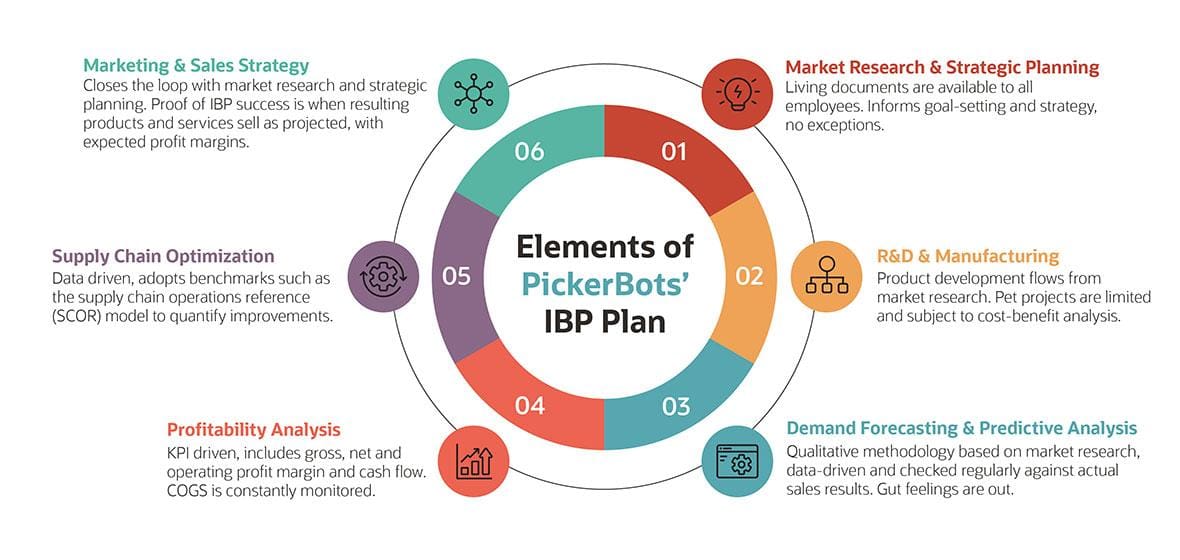
Why Is Integrated Business Planning Important?
Companies that undertake IBP realize a number of practical benefits, including reduced holding costs, more responsive customer service and demand fulfillment, shorter time to market for new products and an improved correlation between demand planning and fulfillment.
After PickerBot’s scenario planning and strategy session, the company decided to jump into the emerging collaborative robot, or cobot, market. A collaborative robot is designed to safely interact with human workers. PickerBot’s leaders believe demand will increase for “pick and place” cobots with fine motor skills for use on manufacturing lines as well as in agricultural settings.
Now that the company has its strategic direction, the COO wants to focus on three higher-level concepts before delving into more practical areas, like financial planning and analysis and supply chain optimization. That’s because without goal-setting, PickerBots won’t be able to define success.
Alignment and accountability
All executives must agree on three things: What are our corporate goals? What does success look like for each? How will I and my team contribute and be accountable?
The company’s goals are grouped into four areas: industry-focused, operations and supply chain, financial and marketing and sales. The management team will review all goals to make sure they align with strategy and are both actionable and achievable.
Industry-focused goal: Offer the most innovative cobots on the market
What success looks like: Develop a product that can match or exceed a human worker in its ability to pick fragile crops without damage.
Who will execute: The R&D team
Financial goal: Diversify revenue streams
What success looks like: Minimize dependence on one market/industry. Add a services arm to generate recurring revenue from maintenance contracts, powered by sensors built in to all new products.
Who will execute: Cross-functional led by CEO and finance
Other goals might be “control costs at each step and deliver cobots to customers on time and to specifications” with an expectation to lower COGS by 10% and raise the company’s Net Promoter Score by 25% within one year. Or for sales, “find 10 new customers for the company’s agricultural cobots and bundle maintenance contracts with each sale.” That ties back to revenue diversification.
An important point: Every manager is accountable for every goal, not just those that lie within their purviews.
Informed decisions and actions
Planning across PickerBots’ supply chain was disjointed, with engineers purchasing materials direct and little central planning or cost control. As part of the IBP process, the company will adopt sales and operations planning (S&OP) principles to improve its supply chain and logistics.
Actionable goals here include building visibility into how each department is working and tying the impact of decisions to financial goals. For example, by having R&D build in sensors that can automatically collect and transmit data on a cobot’s operational status, PickerBots can proactively perform preventative maintenance so the devices are almost never down — an important selling point and a way to contribute to maintenance income.
Organizationwide, divisions need to focus less on their own needs and view actions through the lens of all goals. That means the company needs to collect a lot of timely data and use it to issue reports so managers can make better decisions, more quickly. That may require an investment in ERP and other software.
Transparency/visibility
All department heads will take part in a monthly business review, where the group will assess progress in achieving the company’s objectives. The strategic plan is also available to all staff members, and quarterly all-hands meetings will be held to gather ideas and insights and walk through KPIs.
Four success metrics for the IBP process include:
1. Getting all stakeholders to buy in to corporate goals so that everyone agrees and understands what the business wants to achieve and how it will get there. There are clear responsibilities for each function in the pursuit of goals.
2. Basing business decisions on data. The integration of finance into product, demand and supply functions is key here, as are selecting the right KPIs.
3. Tying decision-making to outcomes and improving accountability. Because every department is responsible for providing accurate numbers and projections, there’s less risk that the CFO and finance team are left holding the bag if revenues fall short.
4. Shifting the culture to embrace cross-functional collaboration. An IBP process encourages openness and trust, and as a result more deeply engages and empowers employees. As an action item, each R&D and manufacturing team member will spend a week annually accompanying sales reps on customer calls.
What Is the Difference Between S&OP and IBP?
The term “IBP” was coined by management consultancy Oliver Wight to describe the next iteration of the sales and operations planning (S&OP) process Wight developed in the early 1980s.
The big difference between IBP and S&OP is that the latter has become the domain of supply chain and logistics specialists, particularly those involved in supply-and-demand balancing and planning. S&OP is execution-focused and involves a traditional budgeting process.
In contrast, IBP takes a more cross-functional and holistic approach to weaving business goals through every function. As a result, in theory, supply chain management is proactive and optimized.
IBP includes S&OP processes but because it involves cultural change, without executive buy-in, IBP will not be successful.
Some major differences between S&OP and IBP are:
6 Steps in the Integrated Business Planning Process
Now that its goals are set, PickerBots can take the next steps in its IBP journey.
1. Determine what is holding the company back. Is it a lack or growth or profitability? Is the product portfolio too complex? Has the business lost competitiveness in its space? For our manufacturing firm, the main problem was overfocus on one niche market.
2. Engage and educate employees. Once leadership buys in to goals, that enthusiasm must trickle down through the ranks. Unless everyone is committed to integrated business planning, success will be elusive. The COO recognizes that a formal employee engagement program will keep workers invested in the success of the business and actively working to meet strategic goals.
3. Set up a tiger team. IBP success comes from tight coordination, constant communication and accountability for KPIs. It’s a cultural shift that will take time to propagate throughout the business. To jumpstart things, PickerBots identified engaged employees within each functional area and assigned them to a daily 20-minute standup call. Now, say a shipment of RFID readers needed by manufacturing will be two weeks late. The purchasing team member shares that information promptly so that sales can manage customer expectations and finance can account for delayed revenue. If the problem recurs, the company can seek out new suppliers. No more surprises.
4. Establish a project/product prioritization process. IBP takes discipline. Only projects that forward the company’s strategic goals get resources. Same for products. That might mean sunsetting a line that’s still selling but lacks growth potential. All managers who require resources or have a product or service launch idea fill out a cost-benefit analysis template that is tailored to reveal whether expected benefits and costs align with goals. Leadership prioritizes using this process. No more sacred cows.
5. Expand the finance team’s influence. Finance needs to sit in on product planning, supply chain optimization and sales strategy meetings. Specifically, choose a finance team member well-versed in FP&A functions. FP&A professionals inform major decisions made by the executive team and collect and analyze financial data from across the organization to create reports that reveal whether goals are being met — and if not, why not? How do we fix the problem? Like many smaller firms, PickerBots doesn’t have a dedicated FP&A staffer, so the head of finance assigns an accounting team member who knows the business and has an aptitude for data collection and number crunching.
6. Adopt technology and tools to support IBP. If the forecasting process is seen as a quarterly or annual exercise imposed by finance and yielding little benefit to departments, IBP can’t succeed. Companies with static, point-in-time budgets need to adopt rolling forecasts to make sure the business stays on track. And, finance teams need to be able to easily access the data they need from each operational area. Both rolling forecasts and better use of data require technology and a commitment to transparency. You can’t manage what you can’t measure.
Traditional vs. Rolling Forecasts
5 tips to succeed at integrated business planning.
Some ways the COO plans to set PickerBots up for success include:
1. Sell IBP as a way to bring order from chaos. For example, large companies, especially those that have engaged in a number of mergers and acquisitions, may have thousands of SKUs and product codes. One big manufacturer Oliver Wight worked with used IBP to whittle 120,000 item numbers down to about 10,000 and reduce inventories by 50% while improving on-time, in-full delivery by up to 20%. For a smaller company, IBP can prevent ever getting in a situation where it needs to slash 90% of SKUs.
2. Adopt a continuous improvement mindset. All parts of any production or service system, particularly people, are interconnected, inform one another and are mutually dependent on generating successful outcomes. This practice’s origin comes from Kaizen, a Japanese term meaning “change for the better.” Originating in Japan, the business philosophy looks to continuously improve operations and involve all employees, from assembly line workers to the CEO. It’s a way to reinforce IBP.
3. Get buy-in from the CIO. PickerBots’ CIO came up through the ranks of manufacturing IT and is familiar with the concept of Total Quality Management (TQM), which has overlap with IBP. That went a long way in communicating the benefits of IBP and freeing up budget for technologies that can make IBP work, like ERP, enterprise performance management (EPM), supply chain management and real-time-capable accounting and finance software — especially important to realize the “one set of numbers” value proposition.
4. Apply risk management principles. Disasters large and small happen. While the zen of IBP skews toward positive and upbeat, make sure department heads are doing scenario planning and what-if analyses to model operational risk — like overdependence on one market. Consider assigning your tiger team a secondary function as a crisis management strike force.
5. Don’t forget HR. Labor is likely your company’s biggest operating expense, so ensure that it’s working for your IBP effort, not against it. A human resources professional can identify traits in applicants — like team players who are data driven and comfortable with transparency — that predict whether they will be contributors to IBP success.
Benefits of Integrated Business Planning
Research shows that the main benefit of implementing IBP is increased revenue, followed by forecast accuracy and improved Perfect Order Delivery rates.
Three additional key benefits:
Real-time insights: Once companies have instituted rolling forecasts, for example, finance can more quickly and accurately answer questions on spending and cash flow. Expect more accurate KPIs across the board.
Ownership: The flip side of accountability is that in a company fully embracing IBP, all employees assume responsibility for meeting all goals. So you’d better make sure that authority to make decisions is decentralized and tied to responsibility for outcomes, because there are few bigger morale killers than accountability without the power to effect success. Companies can further nurture a culture of ownership by tying rewards to meeting or exceeding goals.
Improved customer satisfaction: While more on-time, in-full deliveries make customers happy, that’s not the only way IBP improves Net Promoter Scores. Better planning yields better insights into what customers want, and a strong company culture often leads to improved customer empathy and its associated benefits.
Integrated Business Planning Adoption Challenges
Where a business starts with IBP depends on its maturity. Companies with dog-eat-dog cultures and highly siloed processes have a lot of work to do. These tend to be firms with traditional top-down management structures, static annual budgeting with little ability to generate forward-looking projections and dated business plans that are misaligned with current customer needs.
While all are thorny structural challenges, a leadership team that’s averse to placing trust and decision-making authority at lower levels of the organization is in even worse shape. Companies with autocratic, command-and-control styles must be willing to decentralize authority if they hope to realize IPB’s benefits.
Even businesses with mature, integrated processes and egalitarian cultures often get tripped up by “top down” versus “bottom up” KPI reporting and budgeting. IBP requires businesses to focus less on finance developing a top-line budget and then handing departmental budgets down from on high. Rather, they need to become comfortable with a bottom-up process, where departments start with a plan of what they want to achieve, calculate what it will cost and then feed a number up to the finance team, which uses that input to calculate the total budget.
Companies not already using at least a somewhat flexible budgeting process are likely to find this shift difficult. One way to jump-start the transformation might be a modern form of zero-based budgeting.
Steps of Zero-Based Budgeting for 2021
- Create a strategic vision for ZBB: Identify cost targets, relevant KPIs and goals.
- Evaluate business units to select ZBB candidates (also referred to as “decision units,” or any organ of the business that operates independently with its own budget).
- Start selected budgets from scratch (i.e., from zero).
- Each decision unit provides “decision packages,” which break down each activity in terms of its objective, funding needs, justification in the context of company goals, technical viability and alternative courses of action.
- Evaluate each proposed item to determine its value-add to the company and whether the entire cost is justified. What does the expenditure bring back to the company?
- Prioritize costs based on company goals. Reduce or cut expenses in areas that no longer produce significant value.
- Allocate funds among areas that are productive and aligned with the business’s growth drivers.
Elements of Integrated Business Planning
Integrated business planning takes place at a regular cadence; every month is most common, so we’ll use that in our example.
These steps are standard for IBP consultants, adaptable to most industries and bake in the PickerBots COO’s virtuous cycle of market research and strategic planning, R&D and manufacturing, demand forecasting and predictive analysis, profitability analysis, supply chain optimization and marketing and sales strategy.
1. Product management review. This includes all elements of product portfolio management. A cross-functional team meets monthly to review the overall status of all of product-related projects: Are they on track? Have we identified new risks and opportunities? Are the most high-value products or services prioritized? The goal is aligning the product portfolio with business goals and making sure needed raw materials and manufacturing floor capacity are lined up. Product managers revise as needed and publish an updated master plan, along with the resources it’ll take to deliver any changes.
2. Demand planning picks it up. This is a cross-functional process that helps businesses meet customer demand for products while minimizing excess inventory and avoiding supply chain disruptions. Demand planning can increase profitability and customer satisfaction and lead to efficiency gains. This team brings together members of sales, marketing and finance to determine whether they’re targeting the right markets, the right way. They work up an optimized demand plan. Relevant KPIs include sales forecast accuracy, inventory turns, fill rates and order fulfillment lead times.
3. Then, the ball goes to the supply planning team. These supply chain experts work out the optimal way to meet projected demand in a cost-effective way. The key is to have visibility into complex supply chains; a formal supply chain visibility (SCV) project helps spot and fix weaknesses, such as inventory shortfalls or order fulfillment issues, before they become major problems. Lower cost of goods sold (COGS) is the North star.
4. The integrated reconciliation team pulls together the initial product, demand and supply plans and consolidates them into one holistic business plan based on a 24- or 36-month projection; for iterative updates, teams highlight material changes. Decisions that could not be made by individual teams are prepared for executive review.
5. The executive team resolves conflicts and rolls the updated plan out to the entire company.
Integrated Business Planning Components
The components of integrated business planning comprise three buckets: Plan, execute and monitor and adjust.
Specific actions falling into each bucket vary depending on the consultancy or technology supplier. Some are more aligned with supply chain planning, while others center on S&OP or financial planning with plug-ins to other functional areas. Others are very industry-specific.
Let’s look at Oracle’s IBPX (Integrated Business Planning and Execution) for Manufacturing solution as an example. Key components include:
- Top-down and bottom-up, driver-based planning and forecasting
- Risk modeling for M&A and strategic initiatives
- Full financial statement structure for strategic and operational planning
- Predictive and prescriptive analytics and planning
- A preseeded S&OP process
- Near-real-time demand and supply balancing
- Real-time backlog management
- Automation of predictions and correction actions based on actuals
- AI-enabled operational planning, such as for sales territories and quotas
- IoT and sensor data flows integrated with automated decisions
Items like backlog management and enhanced support for IoT and sensor data are important to manufacturers like PickerBots. A retailer might be more interested in advanced inventory management. What’s important is that any solution, whether purchased as a suite or pulled together by an integrator or in-house team, supports the ability to do long- and medium-range and short-term planning based on a single, up-to-date data set that’s accessible to all authorized stakeholders.
Also look for the ability to easily model “what-if” scenarios, robust budgeting and costing and a roadmap to advanced technologies like AI and predictive analytics.
Integrated Business Planning Examples
We mentioned the Oliver Wight customer that whittled 120,000 SKUs down to about 10,000. That firm, Uponor Group, looked to IBP after a string of acquisitions left it with swelling inventories, an extremely complex portfolio and a lack of communication between siloed functions and far-flung locations. The Finnish company sells products for drinking water delivery as well as radiant heating and cooling equipment and has 3,900 employees in 30 countries. Uponor had a hard time getting a singular view of financial information across its subsidiaries, and each unit had its own practices for inventory management. Small events, such as holidays, would drive some sites to build up “just in case” inventory, and double-stocking in warehouses was common. Subsidiaries in different countries had different SKUs for the same items, and R&D was localized, with no collaboration across the company.
Upinor focused first on its supply chain and implemented S&OP processes, then advanced to IBP the following year. The results have been an increase in net sales of $1.1 billion euros, a 30% improvement in on-time in-full deliveries, a 50% reduction in inventories and increased visibility.
U.S.-based technology provider Juniper Networks also undertook an IBP project focused on implementing a digital supply chain with IBP, where the business planning process would extend S&OP throughout the supply chain, product and customer portfolios, customer demand and strategic planning.
Since undertaking the project, Juniper’s lead-time attainment is up 55%. and its inventory costs are down by 15%, allowing it to realize a positive ROI on the IBC project.
History of Integrated Business Planning
Oliver Wight developed S&OP in the 1980s as a methodology for a client that wanted to balance supply-and-demand volume. In the years since, the process evolved to integrate financials, inventory and new-product introductions.
The consultancy renamed S&OP as integrated business planning in the late 1990s to reflect the process of integrating all functions of the business behind one optimized plan. Since then, a newer term, “enterprise integrated business planning,” has emerged. EIBP includes scenario planning and extended supply chain collaboration and discusses how large companies will adopt new technologies, such as AI, big data and advanced analytics.
#1 Cloud ERP Software
Applications of Integrated Business Planning
IBP makes planning and operations much more transparent, so it’s ideal for companies moving to “just in time” manufacturing. It’s also predictive, once a company builds up some data. That can help with customer satisfaction.
PickerBots, as an example, found that it typically sees constrained supply chain capacity for motherboards in Q3. With that insight, sales and marketing can work to encourage customers to take delivery of systems in Q2 or Q4, manufacturing can prebuild products and supply chain leaders can work on alternate sources for parts that pose challenges.
Looking ahead to the future of IBP, we expect it to help companies:
- Work on ever-longer-range strategy planning, modeling and M&A activities with a higher degree of confidence.
- Detect and notify stakeholders of unanticipated events before they impact the business by using advanced technologies, including real-time sensor information and machine learning (ML) pattern recognition.
As companies build comfort with automation, advanced IBP systems can be set to take action based on analysis without human intervention. Consider a chain of bakeries; a system plugged into a long-range weather forecast system might detect a tropical storm that could raise the price of vanilla and automatically order extra.
Cloud-based technology such as ERP underpins all these advances. For example, PickerBots always set its sales goals monthly. But often these plans were delayed to let the executive team review and approve any changes, meaning operations was caught unawares. A tool like NetSuite Planning and Budgeting automates planning processes and centralizes company financial and operational data, so finance teams can disseminate updates quickly.
The next frontier? Expending IBP to business partners and suppliers, even customers. But first, companies need to get their own cultural and technology houses in order.
Business Strategy

Business Process Automation: Ultimate Guide
A well-run business is always analyzing business processes and finding ways to make them more efficient. It also searches for ways to review, update, change, replace or eliminate its processes on a regular basis in order to…

Trending Articles

Learn How NetSuite Can Streamline Your Business
NetSuite has packaged the experience gained from tens of thousands of worldwide deployments over two decades into a set of leading practices that pave a clear path to success and are proven to deliver rapid business value. With NetSuite, you go live in a predictable timeframe — smart, stepped implementations begin with sales and span the entire customer lifecycle, so there’s continuity from sales to services to support.
Before you go...
Discover the products that 37,000+ customers depend on to fuel their growth.
Before you go. Talk with our team or check out these resources.
Want to set up a chat later? Let us do the lifting.
NetSuite ERP
Explore what NetSuite ERP can do for you.
Business Guide
Complete Guide to Cloud ERP Implementation
Imagine a symphony orchestra where each musician plays their own tune without listening to others. The result would be chaotic and dissonant, right? Similarly, in the business world, when decision-making happens in silos and planning processes are disconnected, it’s like having a group of individuals playing their own instruments without any coordination. The harmony is lost, and the organization becomes inefficient, misses opportunities, and struggles to keep up with the fast-paced market.
Integrated Business Planning (IBP) addresses these challenges by providing a comprehensive framework that integrates strategic, operational and financial planning, analysis, and reporting to drive better business outcomes. A retail company experiences a sudden surge in online sales due to a viral social media campaign. Integrated planning incorporates supply chain planning, demand planning, and demand forecasts so the company can quickly assess the impact on inventory levels, supply chain logistics, production plans, and customer service capacity. By having real-time data at their fingertips, decision-makers can adjust their strategies, allocate resources accordingly, and capitalize on the unexpected spike in demand, ensuring customer satisfaction while maximizing revenue. This blog explores the significance of IBP in today’s modern business landscape and highlights its key benefits and implementation considerations.
Integrated business planning framework
Integrated Business Planning (IBP) is a holistic approach that integrates strategic planning, operational planning, and financial planning within an organization. IBP brings together various functions, including sales, marketing, finance, supply chain, human resources, IT and beyond to collaborate across business units and make informed decisions that drive overall business success. The term ‘IBP’ was introduced by the management consulting firm Oliver Wight to describe an evolved version of the sales and operations planning (S&OP process) they originally developed in the early 1980s.
Making up the Integrated Business Planning framework are six key pillars:
1. strategic planning.
Integrated Business Planning starts with strategic planning. The management team defines the organization’s long-term goals and objectives. This includes analyzing market trends, competitive forces, and customer demands to identify opportunities and threats. Strategic planning sets the direction for the entire organization and establishes the foundation for subsequent planning roadmap.
2. Operational planning
Operational planning focuses on translating strategic goals into actionable plans at the operational level. This involves breaking down the strategic objectives into specific targets and initiatives that different departments and functions need to execute.
For example, the sales department might develop a plan to enter new markets or launch new products, while the supply chain department focuses on inventory optimization and ensuring efficient logistics. The key is to align operational plans with the broader strategic objectives to ensure consistency and coherence throughout the organization.
3. Financial planning
Financial planning ensures that the organization’s strategic and operational plans are financially viable. It involves developing detailed financial projections, including revenue forecasts, expense budgets, and cash flow forecasts. By integrating financial planning with strategic and operational planning, organizations can evaluate financial profitability, identify potential gaps or risks, and make necessary adjustments to achieve financial targets.
4. Cross-functional collaboration
A fundamental aspect of IBP is the collaboration and involvement of various functions and departments within the organization. Rather than working in isolation, departments such as sales, marketing, finance, supply chain, human resources, and IT come together to share information, align objectives, and make coordinated decisions.
5. Data integration and analytics
IBP relies on the integration of data from different sources and systems. This may involve consolidating data from enterprise resource planning (ERP) systems, customer relationship management (CRM) systems, supply chain management systems, and other relevant sources. Advanced analytics and business intelligence tools are utilized to analyze and interpret the data, uncovering insights and trends that drive informed decision-making.
6. Continuous monitoring and performance management
The Integrated Business Planning process requires continuous monitoring of performance against plans and targets. Key performance indicators (KPIs) are established to measure progress and enable proactive management. Regular performance reviews and reporting enable organizations to identify deviations, take corrective actions, and continuously improve their planning processes.
What are the benefits of Integrated Business Planning?
By integrating strategic, operational, and financial planning organizations can unlock the full potential of IBP and drive business success and achieve their goals.
Enhanced decision-making
IBP facilitates data-driven decision-making by providing real-time insights into various aspects of the business. By bringing together data from various departments, organizations can develop a holistic view of their operations, enabling them to make better-informed decisions.
Improved alignment
By aligning strategic objectives with operational plans and financial goals, IBP ensures that every department and employee is working towards a common vision. This alignment fosters synergy and drives cross-functional collaboration.
Agility and responsiveness
In the rapidly changing business landscape, agility is crucial. IBP allows organizations to quickly adapt to market shifts, demand fluctuations, and emerging opportunities. By continuously monitoring and adjusting plans, businesses can remain responsive and seize competitive advantages.
Optimal resource allocation
Integrated Business Planning enables organizations to optimize resource allocation across different functions. It helps identify bottlenecks, allocate resources effectively, and prioritize initiatives that yield the highest returns, leading to improved efficiency and cost savings.
Risk management
IBP facilitates proactive risk management by considering various scenarios and identifying potential risks and opportunities. By analyzing data and conducting what-if analyses, companies can develop contingency plans and mitigate risks before they materialize.
Essential steps for implementing Integrated Business Planning
Implementing an effective IBP process requires careful planning and execution that may require substantial effort and a change of management, but the rewards are well worth it. Here are some essential strategic steps to consider:
1. Executive sponsorship
Establish leadership buy-in; gain support from top-level executives who understand the value of Integrated Business Planning and can drive the necessary organizational changes. Leadership commitment, led by CFO, is crucial for successful implementation.
2. Continuous improvement
Continuously monitor and adjust; implement mechanisms to monitor performance against plans and targets. Regularly review key performance indicators (KPIs), conduct performance analysis, and generate timely reports and dashboards. Identify deviations, take corrective actions, and continuously improve the planning processes based on feedback and insights.
3. Integration of people and technology
To foster cross-functional collaboration, the organization must identify key stakeholders, break down silos, and encourage open communication among departments. Creating a collaborative culture that values information sharing and collective decision-making is essential.
Simultaneously, implementing a robust data integration system, encompassing ERP, CRM, and supply chain management systems, ensures seamless data flow and real-time updates. User-friendly interfaces, data governance, and training provide the necessary technological support. Combining these efforts cultivates an environment of collaboration and data-driven decision-making, boosting operational efficiency and competitiveness.
4. Technology
Implement advanced analytics and business intelligence solutions to streamline and automate the planning process and assist decision-making capabilities. These solutions provide comprehensive functionality, data integration capabilities, scenario planning and modeling, and real-time reporting.
Integrated Business Planning software
From a tech perspective, organizations need advanced software solutions and systems that facilitate seamless data integration and collaboration to support IBP. Here are some key components that contribute to the success of integrated business planning:
1. Corporate performance management
A platform that serves as the backbone of integrated business planning by integrating data from different departments and functions. It enables a centralized repository of information and provides real-time visibility into the entire business.
2. Business intelligence (BI) tools
Business intelligence tools play a vital role in analyzing and visualizing integrated data from multiple sources. These tools provide comprehensive insights into key metrics and help identify trends, patterns, and opportunities. By leveraging BI tools, decision-makers can quickly evaluate financial performance, make data-driven business decisions and increase forecast accuracy.
3. Collaborative planning and forecasting solutions
Collaborative planning and forecasting solutions enable cross-functional teams to work together in creating and refining plans. These planning solutions facilitate real-time collaboration, allowing stakeholders to contribute their expertise and insights. With end-to-end visibility, organizations can ensure that plans are comprehensive, accurate, and aligned with business strategy.
4. Data integration and automation
To ensure seamless data integration, organizations need to invest in data integration and automation tools. These tools enable the extraction, transformation, and loading (ETL) of data from various sources. Automation streamlines data processes reduces manual effort and minimizes the risk of errors or data discrepancies.
5. Cloud-based solutions
Cloud computing offers scalability, flexibility, and accessibility, making it an ideal choice for integrated business planning. Cloud-based solutions provide a centralized platform where teams can access data, collaborate, and make real-time updates from anywhere, at any time. The cloud also offers data security, disaster recovery, and cost efficiencies compared to on-premises infrastructure.
6. Data governance and security
As organizations integrate data from multiple sources, maintaining data governance and security becomes crucial. Establishing data governance policies and ensuring compliance with data protection regulations are vital steps in maintaining data integrity and safeguarding sensitive information. Implementing robust data security measures, such as encryption and access controls, helps protect against data breaches and unauthorized access.
IBM Planning Analytics for Integrated Business Planning
IBM Planning Analytics is a highly scalable and flexible solution for Integrated Business Planning. It supports and strengthens the five pillars discussed above, empowering organizations to achieve their strategic goals and make better data-driven decisions. With its AI- infused advanced analytics and modeling capabilities, IBM Planning Analytics allows organizations to integrate strategic, operational, and financial planning seamlessly. The solution enables cross-functional collaboration by providing a centralized platform where teams from various departments can collaborate, share insights, and align their plans. IBM Planning Analytics also offers powerful data integration capabilities, allowing organizations to consolidate data from multiple sources and systems, providing a holistic view of the business. The solutions’s robust embedded AI predictive analytics uses internal and external data and machine learning to provide accurate demand forecasts. IBM Planning Analytics supports continuous monitoring and performance management by providing real-time reporting, dashboards, and key performance indicators (KPIs) that enable organizations to track progress and take proactive actions. As the business landscape continues to evolve, embracing Integrated Business Planning is no longer an option but a necessity for organizations. To succeed in this dynamic environment, businesses need an integrated approach to planning that brings all the departments and data together, creating a symphony of collaboration and coordination.
More from Artificial intelligence
The power of remote engine execution for etl/elt data pipelines.
5 min read - Business leaders risk compromising their competitive edge if they do not proactively implement generative AI (gen AI). However, businesses scaling AI face entry barriers. Organizations require reliable data for robust AI models and accurate insights, yet the current technology landscape presents unparalleled data quality challenges. According to International Data Corporation (IDC), stored data is set to increase by 250% by 2025, with data rapidly propagating on-premises and across clouds, applications and locations with compromised quality. This situation will exacerbate data silos, increase costs…
Where to begin: 3 IBM leaders offer guidance to newly appointed chief AI officers
4 min read - The number of chief artificial intelligence officers (CAIOs) has almost tripled in the last 5 years, according to LinkedIn. Companies across industries are realizing the need to integrate artificial intelligence (AI) into their core strategies from the top to avoid falling behind. These AI leaders are responsible for developing a blueprint for AI adoption and oversight both in companies and the federal government. Following a recent executive order by the Biden administration and a meteoric rise in AI adoption across…
Scaling generative AI with flexible model choices
5 min read - This blog series demystifies enterprise generative AI (gen AI) for business and technology leaders. It provides simple frameworks and guiding principles for your transformative artificial intelligence (AI) journey. In the previous blog, we discussed the differentiated approach by IBM to delivering enterprise-grade models. In this blog, we delve into why foundation model choices matter and how they empower businesses to scale gen AI with confidence. Why are model choices important? In the dynamic world of gen AI, one-size-fits-all approaches are…
IBM Newsletters
A better way to drive your business
Managing the availability of supply to meet volatile demand has never been easy. Even before the unprecedented challenges created by the COVID-19 pandemic and the war in Ukraine, synchronizing supply and demand was a perennial struggle for most businesses. In a survey of 54 senior executives, only about one in four believed that the processes of their companies balanced cross-functional trade-offs effectively or facilitated decision making to help the P&L of the full business.
That’s not because of a lack of effort. Most companies have made strides to strengthen their planning capabilities in recent years. Many have replaced their processes for sales and operations planning (S&OP) with the more sophisticated approach of integrated business planning (IBP), which shows great promise, a conclusion based on an in-depth view of the processes used by many leading companies around the world (see sidebar “Understanding IBP”). Assessments of more than 170 companies, collected over five years, provide insights into the value created by IBP implementations that work well—and the reasons many IBP implementations don’t.
Understanding IBP
Integrated business planning is a powerful process that could become central to how a company runs its business. It is one generation beyond sales and operations planning. Three essential differentiators add up to a unique business-steering capability:
- Full business scope. Beyond balancing sales and operations planning, integrated business planning (IBP) synchronizes all of a company’s mid- and long-term plans, including the management of revenues, product pipelines and portfolios, strategic projects and capital investments, inventory policies and deployment, procurement strategies, and joint capacity plans with external partners. It does this in all relevant parts of the organization, from the site level through regions and business units and often up to a corporate-level plan for the full business.
- Risk management, alongside strategy and performance reviews. Best-practice IBP uses scenario planning to drive decisions. In every stage of the process, there are varying degrees of confidence about how the future will play out—how much revenue is reasonably certain as a result of consistent consumption patterns, how much additional demand might emerge if certain events happen, and how much unusual or extreme occurrences might affect that additional demand. These layers are assessed against business targets, and options for mitigating actions and potential gap closures are evaluated and chosen.
- Real-time financials. To ensure consistency between volume-based planning and financial projections (that is, value-based planning), IBP promotes strong links between operational and financial planning. This helps to eliminate surprises that may otherwise become apparent only in quarterly or year-end reviews.
An effective IBP process consists of five essential building blocks: a business-backed design; high-quality process management, including inputs and outputs; accountability and performance management; the effective use of data, analytics, and technology; and specialized organizational roles and capabilities (Exhibit 1). Our research finds that mature IBP processes can significantly improve coordination and reduce the number of surprises. Compared with companies that lack a well-functioning IBP process, the average mature IBP practitioner realizes one or two additional percentage points in EBIT. Service levels are five to 20 percentage points higher. Freight costs and capital intensity are 10 to 15 percent lower—and customer delivery penalties and missed sales are 40 to 50 percent lower. IBP technology and process discipline can also make planners 10 to 20 percent more productive.
When IBP processes are set up correctly, they help companies to make and execute plans and to monitor, simulate, and adapt their strategic assumptions and choices to succeed in their markets. However, leaders must treat IBP not just as a planning-process upgrade but also as a company-wide business initiative (see sidebar “IBP in action” for a best-in-class example).
IBP in action
One global manufacturer set up its integrated business planning (IBP) system as the sole way it ran its entire business, creating a standardized, integrated process for strategic, tactical, and operational planning. Although the company had previously had a sales and operations planning (S&OP) process, it had been owned and led solely by the supply chain function. Beyond S&OP, the sales function forecast demand in aggregate dollar value at the category level and over short time horizons. Finance did its own projections of the quarterly P&L, and data from day-by-day execution fed back into S&OP only at the start of a new monthly cycle.
The CEO endorsed a new way of running regional P&Ls and rolling up plans to the global level. The company designed its IBP process so that all regional general managers owned the regional IBP by sponsoring the integrated decision cycles (following a global design) and by ensuring functional ownership of the decision meetings. At the global level, the COO served as tiebreaker whenever decisions—such as procurement strategies for global commodities, investments in new facilities for global product launches, or the reconfiguration of a product’s supply chain—cut across regional interests.
To enable IBP to deliver its impact, the company conducted a structured process assessment to evaluate the maturity of all inputs into IBP. It then set out to redesign, in detail, its processes for planning demand and supply, inventory strategies, parametrization, and target setting, so that IBP would work with best-practice inputs. To encourage collaboration, leaders also started to redefine the performance management system so that it included clear accountability for not only the metrics that each function controlled but also shared metrics. Finally, digital dashboards were developed to track and monitor the realization of benefits for individual functions, regional leaders, and the global IBP team.
A critical component of the IBP rollout was creating a company-wide awareness of its benefits and the leaders’ expectations for the quality of managers’ contributions and decision-making discipline. To educate and show commitment from the CEO down, this information was rolled out in a campaign of town halls and media communications to all employees. The company also set up a formal capability-building program for the leaders and participants in the IBP decision cycle.
Rolled out in every region, the new training helps people learn how to run an effective IBP cycle, to recognize the signs of good process management, and to internalize decision authority, thresholds, and escalation paths. Within a few months, the new process, led by a confident and motivated leadership team, enabled closer company-wide collaboration during tumultuous market conditions. That offset price inflation for materials (which adversely affected peers) and maintained the company’s EBITDA performance.
Our research shows that these high-maturity IBP examples are in the minority. In practice, few companies use the IBP process to support effective decision making (Exhibit 2). For two-thirds of the organizations in our data set, IBP meetings are periodic business reviews rather than an integral part of the continuous cycle of decisions and adjustments needed to keep organizations aligned with their strategic and tactical goals. Some companies delegate IBP to junior staff. The frequency of meetings averages one a month. That can make these processes especially ineffective—lacking either the senior-level participation for making consequential strategic decisions or the frequency for timely operational reactions.
Finally, most companies struggle to turn their plans into effective actions: critical metrics and responsibilities are not aligned across functions, so it’s hard to steer the business in a collaborative way. Who is responsible for the accuracy of forecasts? What steps will be taken to improve it? How about adherence to the plan? Are functions incentivized to hold excess inventory? Less than 10 percent of all companies have a performance management system that encourages the right behavior across the organization.
By contrast, at the most effective organizations, IBP meetings are all about decisions and their impact on the P&L—an impact enabled by focused metrics and incentives for collaboration. Relevant inputs (data, insights, and decision scenarios) are diligently prepared and syndicated before meetings to help decision makers make the right choices quickly and effectively. These companies support IBP by managing their short-term planning decisions prescriptively, specifying thresholds to distinguish changes immediately integrated into existing plans from day-to-day noise. Within such boundaries, real-time daily decisions are made in accordance with the objectives of the entire business, not siloed frontline functions. This responsive execution is tightly linked with the IBP process, so that the fact base is always up-to-date for the next planning iteration.
A better plan for IBP
In our experience, integrated business planning can help a business succeed in a sustainable way if three conditions are met. First, the process must be designed for the P&L owner, not individual functions in the business. Second, processes are built for purpose, not from generic best-practice templates. Finally, the people involved in the process have the authority, skills, and confidence to make relevant, consequential decisions.
Design for the P&L owner
IBP gives leaders a systematic opportunity to unlock P&L performance by coordinating strategies and tactics across traditional business functions. This doesn’t mean that IBP won’t function as a business review process, but it is more effective when focused on decisions in the interest of the whole business. An IBP process designed to help P&L owners make effective decisions as they run the company creates requirements different from those of a process owned by individual functions, such as supply chain or manufacturing.
One fundamental requirement is senior-level participation from all stakeholder functions and business areas, so that decisions can be made in every meeting. The design of the IBP cycle, including preparatory work preceding decision-making meetings, should help leaders make general decisions or resolve minor issues outside of formal milestone meetings. It should also focus the attention of P&L leaders on the most important and pressing issues. These goals can be achieved with disciplined approaches to evaluating the impact of decisions and with financial thresholds that determine what is brought to the attention of the P&L leader.
The aggregated output of the IBP process would be a full, risk-evaluated business plan covering a midterm planning horizon. This plan then becomes the only accepted and executed plan across the organization. The objective isn’t a single hard number. It is an accepted, unified view of which new products will come online and when, and how they will affect the performance of the overall portfolio. The plan will also take into account the variabilities and uncertainties of the business: demand expectations, how the company will respond to supply constraints, and so on. Layered risks and opportunities and aligned actions across stakeholders indicate how to execute the plan.
Would you like to learn more about our Operations Practice ?
Trade-offs arising from risks and opportunities in realizing revenues, margins, or cost objectives are determined by the P&L owner at the level where those trade-offs arise—local for local, global for global. To make this possible, data visible in real time and support for decision making in meetings are essential. This approach works best in companies with strong data governance processes and tools, which increase confidence in the objectivity of the IBP process and support for implementing the resulting decisions. In addition, senior leaders can demonstrate their commitment to the value and the standards of IBP by participating in the process, sponsoring capability-building efforts for the teams that contribute inputs to the IBP, and owning decisions and outcomes.
Fit-for-purpose process design and frequency
To make IBP a value-adding capability, the business will probably need to redesign its planning processes from a clean sheet.
First, clean sheeting IBP means that it should be considered and designed from the decision maker’s perspective. What information does a P&L owner need to make a decision on a given topic? What possible scenarios should that leader consider, and what would be their monetary and nonmonetary impact? The IBP process can standardize this information—for example, by summarizing it in templates so that the responsible parties know, up front, which data, analytics, and impact information to provide.
Second, essential inputs into IBP determine its quality. These inputs include consistency in the way planners use data, methods, and systems to make accurate forecasts, manage constraints, simulate scenarios, and close the loop from planning to the production shopfloor by optimizing schedules, monitoring adherence, and using incentives to manufacture according to plan.
Determining the frequency of the IBP cycle, and its timely integration with tactical execution processes, would also be part of this redesign. Big items—such as capacity investments and divestments, new-product introductions, and line extensions—should be reviewed regularly. Monthly reviews are typical, but a quarterly cadence may also be appropriate in situations with less frequent changes. Weekly iterations then optimize the plan in response to confirmed orders, short-term capacity constraints, or other unpredictable events. The bidirectional link between planning and execution must be strong, and investments in technology may be required to better connect them, so that they use the same data repository and have continuous-feedback loops.
Authorize consequential decision making
Finally, every IBP process step needs autonomous decision making for the problems in its scope, as well as a clear path to escalate, if necessary. The design of the process must therefore include decision-type authority, decision thresholds, and escalation paths. Capability-building interventions should support teams to ensure disciplined and effective decision making—and that means enforcing participation discipline, as well. The failure of a few key stakeholders to prioritize participation can undermine the whole process.
Decision-making autonomy is also relevant for short-term planning and execution. Success in tactical execution depends on how early a problem is identified and how quickly and effectively it is resolved. A good execution framework includes, for example, a classification of possible events, along with resolution guidelines based on root cause methodology. It should also specify the thresholds, in scope and scale of impact, for operational decision making and the escalation path if those thresholds are met.

Transforming supply chains: Do you have the skills to accelerate your capabilities?
In addition to guidelines for decision making, the cross-functional team in charge of executing the plan needs autonomy to decide on a course of action for events outside the original plan, as well as the authority to see those actions implemented. Clear integration points between tactical execution and the IBP process protect the latter’s focus on midterm decision making and help tactical teams execute in response to immediate market needs.
An opportunity, but no ‘silver bullet’
With all the elements described above, IBP has a solid foundation to create value for a business. But IBP is no silver bullet. To achieve a top-performing supply chain combining timely and complete customer service with optimal cost and capital expenditures, companies also need mature planning and fulfillment processes using advanced systems and tools. That would include robust planning discipline and a collaboration culture covering all time horizons with appropriate processes while integrating commercial, planning, manufacturing, logistics, and sourcing organizations at all relevant levels.
As more companies implement advanced planning systems and nerve centers , the typical monthly IBP frequency might no longer be appropriate. Some companies may need to spend more time on short-term execution by increasing the frequency of planning and replanning. Others may be able to retain a quarterly IBP process, along with a robust autonomous-planning or exception engine. Already, advanced planning systems not only direct the valuable time of experts to the most critical demand and supply imbalances but also aggregate and disaggregate large volumes of data on the back end. These targeted reactions are part of a critical learning mechanism for the supply chain.
Over time, with root cause analyses and cross-functional collaboration on systemic fixes, the supply chain’s nerve center can get smarter at executing plans, separating noise from real issues, and proactively managing deviations. All this can eventually shorten IBP cycles, without the risk of overreacting to noise, and give P&L owners real-time transparency into how their decisions might affect performance.
P&L owners thinking about upgrading their S&OP or IBP processes can’t rely on textbook checklists. Instead, they can assume leadership of IBP and help their organizations turn strategies and plans into effective actions. To do so, they must sponsor IBP as a cross-functional driver of business decisions, fed by thoughtfully designed processes and aligned decision rights, as well as a performance management and capability-building system that encourages the right behavior and learning mechanisms across the organization. As integrated planning matures, supported by appropriate technology and maturing supply chain–management practices, it could shorten decision times and accelerate its impact on the business.
Elena Dumitrescu is a senior knowledge expert in McKinsey’s Toronto office, Matt Jochim is a partner in the London office, and Ali Sankur is a senior expert and associate partner in the Chicago office, where Ketan Shah is a partner.
Explore a career with us
Related articles.

To improve your supply chain, modernize your supply-chain IT

Supply-chain resilience: Is there a holy grail?
- Webinar Replays
- News & Press
- User Groups
- Brand Ambassadors
- OneStream Press
- Solution Exchange
- PartnerStream
- Financial Close & Consolidation
- Financial Signaling
- Reporting & Analytics
- Financial Data Quality
- Account Reconciliations
- Transaction Matching
- Compliance Solutions
- Tax Provision
- ESG Reporting & Planning
- Planning, Budgeting & Forecasting
- AI Financial Forecasting
- People Planning
- Capital Planning
- Sales Planning
- Profitability Analysis
- Manufacturing
- Financial Services
- Public Sector
- Higher Education
- Oracle Hyperion Conversion
- SAP ERP Customers

- Consulting Services
- Certification Program
- ONECommunity

- Customer Success
- News & Press
What is Integrated Business Planning and What Are The Benefits?

If there is one thing any business analyst can forecast is this: sustained uncertainty. And organizations can’t do much to change this. What organizations can do though, is to prepare to deal with market variability by addressing the business challenges internal organizations may have: disconnected and lengthy planning processes, an insane amount of time collating data, siloed decision-making, lack of forecasting accuracy, poor sight into operational assumptions and what is driving margin. That’s what Integrated Business Planning is aiming for.
What is Integrated Business Planning (IBP)?
Integrated Business Planning aims to unify business strategy with planning, budgeting and forecasting activity for all business lines and functions – providing one version of the numbers. A trusted, common view of the numbers provides a robust baseline for agile decision-making and keeps all teams together, collectively trying to achieve the same corporate objectives while staying focused on specific KPIs. In other words, the different teams maintain their independence while working in unison to achieve corporate success by leveraging the same trusted and governed data.
The bottom line is that IBP is about aligning strategy intent, unifying planning processes and bringing the organization together.
IBP Process: How Does it Work
The Integrated Business Planning process is a framework to address the C-suite needs and help them implement the business strategy and manage uncertainty to improve decision-making. The secret sauce of IBP is a collaboration between the different teams under a single view of the numbers that must unequivocally be tied to financial performance, that’s how the C-suite gets value from it. Consequently, finance plays a central role within IBP.
IBP typically focuses on 24- 60 months horizons, as opposed to short term: that’s Integrated Tactical Planning or Sales and Operations Planning and Execution. The process must be fully integrated, so it should remove the departmental silos and it must adapt to the organizational construct of every business (it is not a one size fits all type of process).
Figure 1 outlines the five core elements of the IBP cycle with its responsibilities:
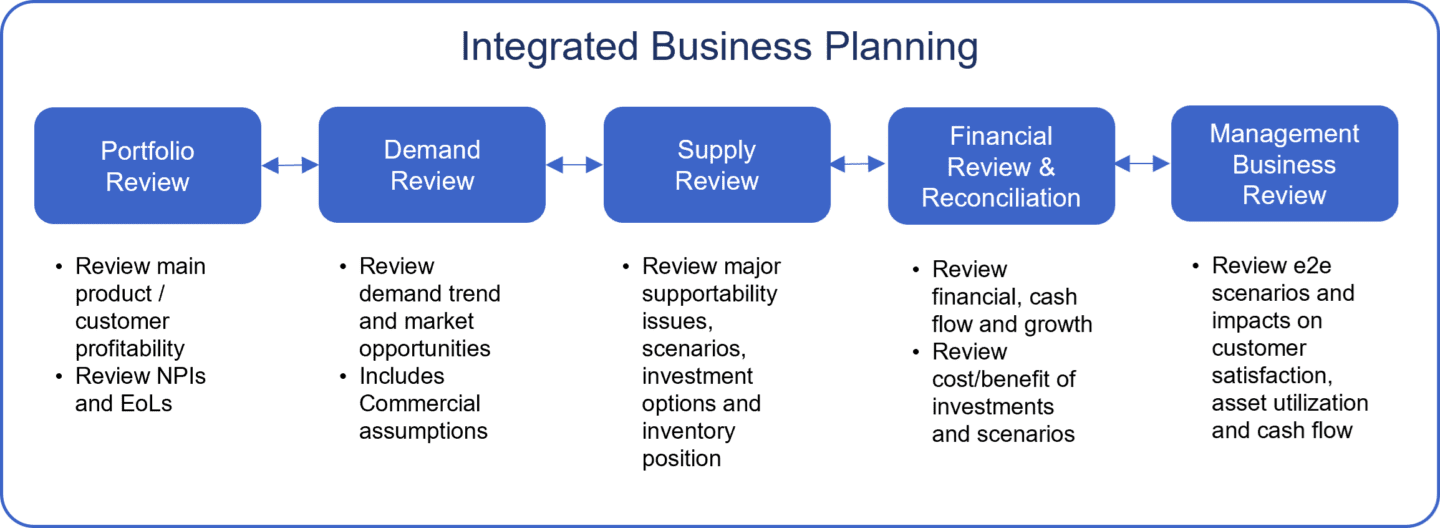
The most efficient way to foster this collaboration is by having a unified solution and data model that caters the needs of the various agents involved on each review. Figure 2 shows how one solution gathering all the capabilities in the greyed area under a unified data model is the most efficient approach to IBP.
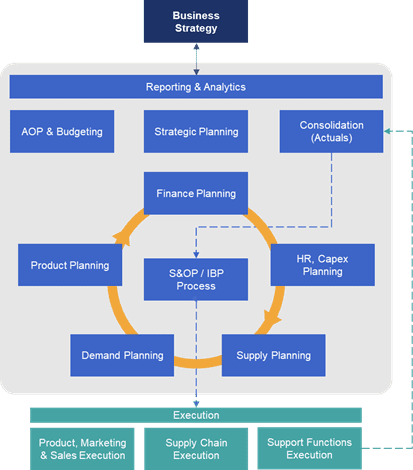
IBP Business Benefits
The benefits an organization can expect from an IBP implementation are diverse. In the big picture, IBP can certainly improve financial and business performance. Figure 3 outlines some of the most remarkable KPI improvements.
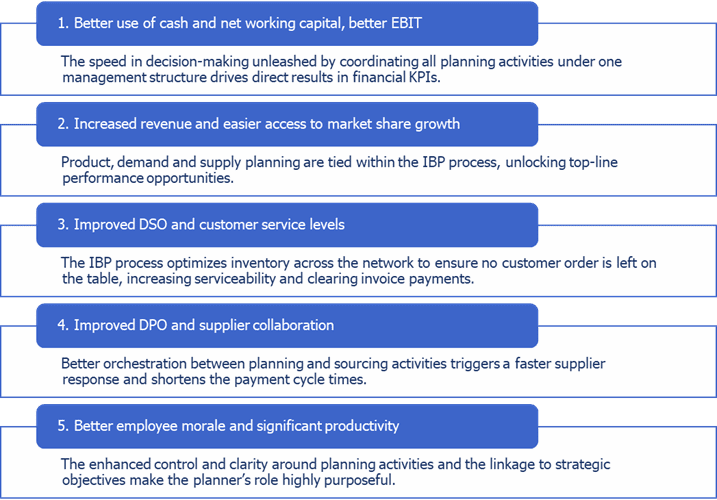
Want to learn how you can maximize the benefits of your IBP process and get your CEO onboard, read our blog on the 5 Considerations to Help Your CEO Trust the IBP Process .
Get Started With a Personal Demo

Streamline Financial Processes
- my. Inchainge
- Integrated Business Planning
What is Integrated Business Planning (IBP)? And what are the similarities, but also differences when compared to S&OP? In this article, Inchainge discusses everything you need to know about IBP.
What is integrated business planning (IBP)?
Integrated Business Planning (IBP) is the business planning process that extends the principles of Sales and Operations Planning (S&OP) throughout the value chain . It is to create a bridge between strategy and execution. IBP is a next step for companies that already have an S&OP process in place. It is a next step because it integrates the Financial Planning Cycle. The financial function will become part of this cross-functional process. In most companies the business owner of this process will change as well.
Similarities between IBP and S&OP
Integrated Business Planning and Sales and Operations Planning have several similarities between them. These are as follows:
- Monthly process
- Cross-functional approach
- Driven by business strategy
- Tactical planning at an aggregated level
Differences between IBP and S&OP
However, Integrated Business Planning includes content on top of Sales and Operations Planning:
- Financial function involved
- Integration financial planning cycle, like financial budget and forecast
- From volume planning to volume and value planning
- It drives the overall business performance
How does the IBP process work?
Companies have an annual budget cycle, based on their strategic plans and targets. The annual budget projects planned revenues and costs for the year.
In traditional S&OP companies go through a monthly process during which they project for the next 6 to 24 months where demand will go, and what resources need to be available to meet that demand. When gaps are discovered between expected demand and available resources looking this far ahead into the future, this often provides ample time to balance supply and demand, so that by the time real customer orders are submitted, demand can be met.
Suppose that during this monthly S&OP cycle, one would also look 6 to 24 months into the future where expected revenues and costs will go. And how these financial figures would look compared to the annually budgeted revenues and cost. Most likely gaps will occur here as well between the annually budgeted numbers and the monthly updated numbers. Actions could then be taken to address these gaps. Integrating a financial view. When this happens, we actually practice IBP. In IBP the relationship with the financial performance management cycle is very important. Budget and financial forecasting must be aligned and integrated with the steps from the original S&OP cycle.
The challenges of IBP
IBP is a next step in maturity after companies have implemented a proper S&OP process. Integrating finance sounds simple but is not easy at all. People from the physical supply chain side of the business, often speak a different language than people who operate on the financial side. Supply chain people often speak about units, products, and product families, whereas financial people often speak about money, currencies, etc. That also causes both functional areas to be assessed differently with the KPIs that they use. This calls for other participants in the IBP process, compared to participants in the S&OP process.
The 8 common pitfalls when implementing IBP
Be aware of the following risks related to integrated business planning:
- Lack of commitment in some of the needed departments
- If the S&OP process was not yet implemented or stable, IBP is too big of a step
- Targets and forecasts are mixed
- Information not available
- Discussion about numbers instead of the underlying assumptions
- Discussing only short horizon instead of midterm
- Too granular plans and discussions
- Thorough understanding of trade-offs is lacking
Want to know more? Experience IBP!
Because IBP is simple but not easy, a real-life experience creates enormous value for learning about this topic. The participants will feel and recognize the important issues in this process. In our business simulation game, The Cool Connection , we have incorporated the most important functions and decisions.
In this business game the team is forced to make a yearly financial budget and quarterly forecasts. The objective is to close the gaps between prediction (the budget and forecasts) on one hand and attained performance on the other. The best performing teams are both profitable and predictable at the same time. In business game The Cool Connection the team is almost experiencing a real-life IBP process.
Besides our business games, you can learn more in our articles about topics such as Total Cost of Ownership (TCO) , strategic alignment and external alignment and collaboration .
Now you know
Now you know that IBP is a next step for companies that already have an S&OP process in place, by integrating the financial planning cycle in this cross-functional process. IBP prompts companies to include planned revenues and costs in their annual budget cycle. Budget and financial forecasting must be aligned and integrated with the steps from the original S&OP cycle. Integrating finance sounds simple but is not easy at all. Supply chain people and finance people tend to speak a different language. Make sure to be aware of the 8 common pitfalls when implementing IBP.
You might want to learn more about

Learning is the process of acquiring new understanding, knowledge, behaviors, skills, values, attitudes, and preferences. There are many ways to learn but what works best? And why does it matter? In this article, Inchainge discusses everything you need to know about learning.

The Cool Connection
The Cool Connection is an innovative web-based business simulation game. It engages participants in making strategic decisions in the management of a manufacturing company of personal care products. Working in teams of four, participants will represent the functional roles of sales, purchasing, supply chain management and finance. They will be confronted with various real-life, real-time dilemmas.

- Total Cost of Ownership
When buying new equipment, the price tag only tells you part of the story. Energy costs, maintenance, and repair fees are often several times higher than the initial price! But often these are left unconsidered and hold nasty surprises further down the line. Calculating the Total Cost of Ownership is an important step when planning new investments.

- Strategic Alignment
Understanding what strategic alignment really is and why it is important can make the difference between being a successful company and failing. Due to its complexity, the supply chain often faces challenges in aligning its strategy properly and working as one. In this article, Inchainge discusses everything you need to know about strategic alignment.

- External Alignment and Collaboration
In an increasingly global and connected world, companies rarely execute supply chain operations themselves, but must outsource certain tasks. To make sure that supply chains across several companies run smoothly, external alignment is essential. In this article, we’ll discuss everything you need to know about external alignment.
Dive into our knowledge base
- Key Performance Indicators
- Sales & Operations Planning
- Blended learning
- Delivery formats and scalability
- Experiential learning
- Flipped classroom
- Learning cycle
- Soft skills
- Building (virtual) teams
- Leadership skills
Supply chain
- Data analytics
- End-to-end Supply Chain Management
- LARG Supply Chain
- Logistics footprint
- Omnichannel
- Supply Chain
- Supply Chain Finance
- Supply Chain Management
- Supply Chain Risk management
- Supply Chain Volatility
- The Bullwhip Effect
- Sustainability
- Carbon footprint
- Circular Economy
- Does Green Governance drive the ride to a sustainable future?
- Everything You Need To Know About Eco-Efficiency
- Greenwashing: Everything you need to know
- Is it possible to measure the Triple Bottom Line?
- Sustainability v/s Circularity
- The 3Ps Series: People
- The 3Ps Series: Planet
- The 3Ps Series: Prosperity
- The Butterfly Diagram
- The Value Hill
- What are the 3Ps of Sustainability?
- What do we know about the Triple Bottom Line?
- Value Chain
Privacy Overview
- Recognition

Integrated Business Planning
Embracing change: the power of integrated business planning.
In today’s dynamic business landscape, conventional planning processes riddled with departmental silos often hinder visibility and efficiency. However, a transformative shift is underway. Forward-thinking companies are embracing digital transformation and adopting Integrated Business Planning (IBP) to empower their activities with enhanced coordination and collaboration. This blog delves into the definition of IBP and explores the substantial benefits it’s brings to organizations in a modern setting.
What is Integrated Business Planning?
IBP is considered a best practice approach that seamlessly integrates financial and operational data from across the organization. This strategic method allows companies to optimize their output by connecting strategic plans with sales, operational, and financial plans. The result is enhanced visibility of the intricate relationships between resources, capabilities, and results. Through IBP, organizations collectively develop a comprehensive go-to-market plan that reflects contributions from every department.
Main objectives of Integrated Business Planning
IBP establishes a framework to achieve the following key goals:
- Align company plans and resources with corporate strategy: IBP ensures that all parts of the business are aligned with the strategic goals, focusing on financial performance as much as on operational capabilities.
- Improve visibility and collaboration across the business: By bringing together various functions—such as sales, production, logistics, and finance—IBP fosters collaboration and transparency across departments.
- Enable more accurate and forward-looking decision-making: With a unified view of business data and forecasts, companies can make more informed decisions, anticipate market changes, and react proactively.
Core elements of Integrated Business Planning
IBP consists of a series of interconnected processes that work together to create a unified business plan:
- Product and portfolio management: Managing the life cycle of products and aligning the product portfolio with market demands and strategic objectives.
- Demand planning: Estimating customer demand to guide supply chain and business planning.
- Supply planning: Ensuring the organization can meet the demand plans with optimal resources.
- Financial review and integration: Tying operational planning to financial planning and analysis to ensure that business plans are financially viable and aligned with financial goals.
- Strategic business planning: Aligning all business plans with the company’s long-term strategic goals, including financial objectives.
- Integrated reconciliation: Harmonizing plans across the business to ensure alignment and commitment from all departments.
Key benefits of Integrated Business Planning
IBP offers a multitude of advantages, including:
- Enhanced agility: Respond faster to market changes and capitalize on new opportunities.
- Improved financial performance: Make data-driven decisions that optimize resource allocation and profitability.
- Better risk management: Proactively identify and mitigate potential risks that could impact your business.
- Increased collaboration: Break down departmental silos and foster a culture of teamwork.
- More accurate forecasting: Gain a clearer picture of future demand and supply to optimize inventory levels.
While IBP requires a mature planning process with the right technology and tools, successful implementation also depends on strong leadership, clear communication, and a collaborative culture across all levels of the organization. It’s a strategic approach that, when executed well, can significantly enhance a company’s performance and competitive edge.
Challenges of traditional business planning processes
Conventional planning activities are often disjointed, especially across the supply chain. The use of disparate spreadsheets and standalone business intelligence solutions creates isolated pockets of knowledge, hindering a holistic approach to planning. While some firms implement Sales and Operations Planning (S&OP) principles, true unification across the entire organization remains elusive. This fragmented approach leads to inefficiencies and suboptimal performance due to:
- Limited visibility into departmental activities and their impact on the financial bottom line.
- Disconnection between strategies and operational activities, resulting in delayed responses to market changes.
- Lack of a collaborative approach and accountability, fostering business silos rather than a unified team.
- Multiplicity of point solutions and applications across divisions, increasing costs and data disparities.
Overcoming these challenges requires a shift towards a unified planning process. IBP offers a comprehensive framework that breaks down departmental silos, integrates financial and operational data, and fosters a culture of collaboration. By implementing IBP, organizations can gain a clear view of their business, make better decisions, and achieve their strategic objectives.
Integrated Business Planning vs Sales and Operations Planning: What’s the difference?
IBP and S&OP are both strategic processes used by companies to align various functions within the organization. While they share similarities in aiming to improve business performance through better planning and alignment, there are distinct differences in scope, focus, and depth.
Here’s a comparison between the two:
Key differentiators
- Breadth: IBP takes a more comprehensive approach, encompassing the entire organization’s planning processes. S&OP has a narrower focus on aligning supply chain operations.
- Time horizon: IBP has a longer-term perspective, considering market trends and setting strategic direction. S&OP prioritizes short-term efficiency and meeting near-term targets.
- Financial emphasis: IBP integrates financial planning with operations, ensuring financial viability. S&OP gives less weight to financial considerations, focusing on operational costs.
- Decision-making: IBP empowers decision-making across all levels, while S&OP primarily supports operational-level choices.
IBP builds upon the foundation of S&OP. It extends the principles of supply chain alignment to encompass broader financial and strategic planning. While both processes are valuable, IBP offers a more holistic and future-oriented approach for businesses seeking to optimize performance across the entire organization.
Case in point: Coca-Cola European Partners
Automating 90% of financial data input, slashing data transfer time from 24 hours to 15 minutes, and enabling digital, driver-based planning from production to delivery.
Coca-Cola European Partners (CCEP) leveraged IBP to transform their supply chain finance function. They implemented driver-based planning, which integrates financial and operational data, enabling them to make data-driven decisions and optimize resource allocation. IBP also improved collaboration across departments by providing a single platform for all users to access and analyze data.
This resulted in:
- considerable savings in time: a 90% reduction of manual tasks
- improved efficiency of data transfers: from 24 hours to 15 minutes
- a streamlined consolidation process: just one-click to incorporate 48 plants and 85 warehouses
Overall, IBP increased transparency, streamlined processes, and empowered informed decision-making at CCEP.
The future of business planning
The era of disjointed planning processes is giving way to the transformative power of IBP. Companies adopting it can unlock improved visibility, collaboration, and efficiency—setting the stage for sustained success in today’s rapidly evolving business landscape.
For further insights, explore our complimentary whitepapers and reports on the benefits of an IBP process.
From the author

Unlocking value through Integrated Business Planning: the experts share their thoughts
Tired of siloed departments and disconnected planning? There’s a better way. Integrated Business Planning (IBP)…


Harness the power of Integrated Business Planning with your guide to success
Great news for businesses looking to streamline their planning processes and achieve strategic alignment! We’re…
Be the first to comment on this post Cancel reply
Your email address will not be published. Required fields are marked *
- End-to-End Strategy & FP
- Infrastructure Strategy & CP
- Business Continuity & SCRM
- Production Strategy
- Network Design
- Supply/Inventory Planning
- Product & Customer Profitability
- Sourcing & Procurement
- Production Scheduling
- Order Allocation
- Our Leadership & Board
- Testimonials
- Our Partners
- Schedule Demo

Share This Blog
At its finest, IBP is fully aligned with growth and innovation metrics, having turned S&OP into a strategic business partner. Visualize aligning your company’s operational decisions with forward-looking financial performance across various timeframes, representing complex trade-offs, constraints, and real-time business realities across the value chain; this is what a successful IBP looks like!
For more than a decade, our customers have struggled with the term IBP and how it relates to sales and operations planning (S&OP), sales and operations execution (SOE) sales inventory operations planning (SIOP), sales and operations management (S&OM), and other processes.
Despite knowing its importance, businesses have been slow to adopt integrated business planning. Many have yet to establish a fluid S&OP process.
Why Companies Struggle to Adopt IBP
So…why are companies still struggling to adopt IBP? A few reasons include:
- Conflicting goals among business units and barriers due to the evolutions of processes and technologies
- Existing technology design
- Traditional methods of doing business
A recent study shows that 79% of companies continue to use spreadsheet planning, yet only 39% say that spreadsheets support a collaborative planning process .
( Download the research perspective here for more insights and how to tackle problems with spreadsheet planning. )
Here’s the problem: Inflexible tools like spreadsheets don’t allow for a cross-functional representation of the business. Also, spreadsheets don’t provide forward-looking insights — a requirement for IBP. Instead, spreadsheets produce infeasible plans, inhibit collaborative planning, and suck loads of time that could be better spent elsewhere.
In one case study, a snack food giant wasn’t meeting demand on its most profitable product due to constrained capacities. When it tried utilizing its 20+ spreadsheets, they continued to fall short of reaching targets and became well aware that they were missing out on major profit opportunities.
Spreadsheets may work for isolated scenarios but not integrating functions to solve one common goal (meeting demand) while aligning with strategic objectives (e.g., recognizing additional profit opportunities). This is the essence of integrated business planning
Top 7 Barriers to Integrated Business Planning
In addition to spreadsheets, here are a few other barriers that we have found:
- Technology and process structures don’t allow integration. Traditional software solution designs differ in structure, hindering integration. Supply chain software was built from the ground up with a data model that was singularly focused toward certain areas like demand, supply, logistics, etc. Financial planning and analysis tools which model the General Ledger/Chart of Accounts from a transactional and roll-up perspective take the opposite approach. As such, supply chain planning and financial planning technologies were never destined to meet.
- Complex skill set required. Optimization solutions present barriers within barriers: modeling a complex supply chain often requires difficult coding and provides no visualization.
- Different cultures within the organization. Business units within the enterprise usually have a culture of its own; the undertaking of understanding another unit’s goals while striving to reach its own seemed impossible.
- Linear scenario management tools. Like optimization, scenario management tools can’t replicate real-world complexities, nor acknowledge that what-ifs are not linear.
- Use of spreadsheets as a primary planning tool. Maintaining the status quo use of spreadsheets presents an inflexible resource unable to integrate and align business goals.
- Inflexible solutions prevent data quality, access, and management. Solutions are designed to operate a specific way, and often unlike the business, meaning that the access to data or its quality and management are reliant upon the system.
- No C-Suite awareness. Understanding the meaning and feasibility of IBP often lies outside the C-Suite periphery. As a relatively new process that has been difficult to put into practice, IBP is an educational endeavor within the organization; IBP fails to get the attention of the C-Suite that benefits from it most. The CEO/CFO can be unaware of the benefits of IBP. In this post, we describe situations where employees keep profit-improving opportunities a secret , because an individual silo may be somewhat negatively impacted.

Clearly, navigating the challenges to implementing IBP starts with understanding the advantages that IBP provides.
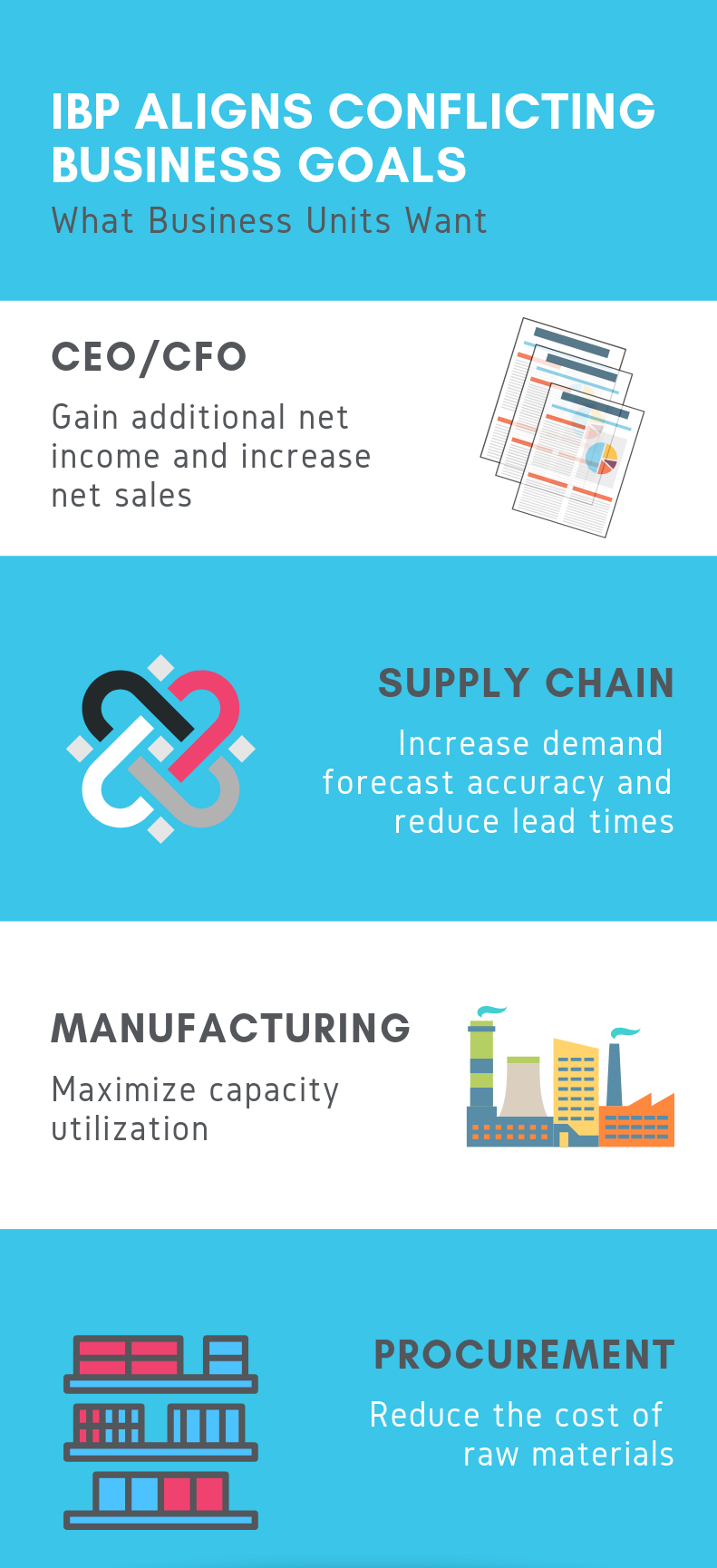
How Does IBP Work?
IBP represents the end-to-end business goals with a process that takes into consideration each business silo and its various functions. For example, is the operational plan represented in a cash flow statement? If not, what good is an operating plan that includes a product mix with margin contributions that put cash flow risk? It’s why the outcome of IBP is a true business plan, rather than a demand plan, supply plan, production plan, or a financial budget.
Through IBP, enterprises gain a single holistic plan that unifies the business, seamlessly connecting corporate performance management, financial planning processes, and operational planning systems. This comprehensive business plan increases business alignment through the sharing of performance strategies and helps quantify business risk so enterprises can rapidly adapt to meet challenges.
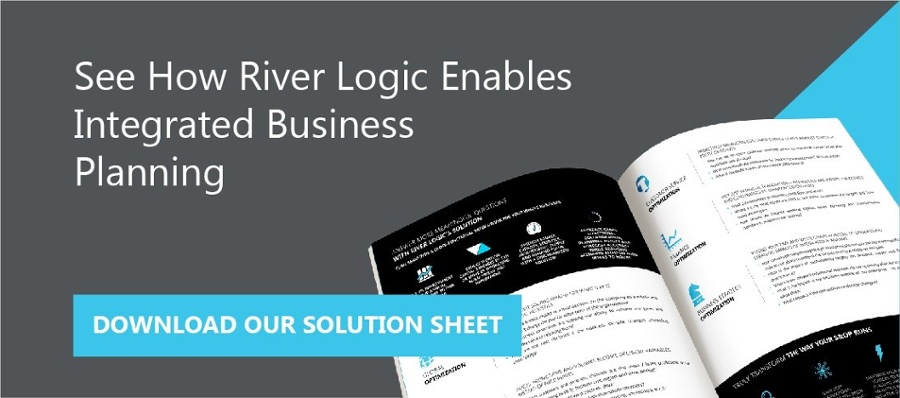
Why We Need IBP Now More than Ever
Even in a good economy, financial pressure to perform is paramount to maintaining a competitive edge and interesting enough, no different than the factors driving IBP following the 2009 recession. These include:
- Demand volatility has increased considerably for most companies.
- Supply complexity has increased with options such as subcontracting manufacturing and logistics operations — both of which are more common. Supply chains are broader in scope, including goods that are distributed across worldwide supply chains.
- Input cost volatility is a constant, increasing challenge for profitability. No matter the commodity (e.g., aluminum, gas, or petrochemicals), all experience sudden market changes.
- Non-linear connection between costs and volume fluctuates with a mix of fixed and variable costs; some costs vary by volume and others by time, making it more difficult to understand the financial implications of business decisions.
Yet, IBP is essentially an outgrowth of S&OP that fully aligns customer, product, demand, product, and strategic portfolios across a value chain to drive the strategy of a company, its financial performance, and its operational and tactical plans. This realization began as early as decades ago but hasn’t gained much traction in implementation until recently.
With process changes like global sourcing and distribution, the complexities of the supply chain make it necessary to synchronize operational plans with financial and strategic business goals and understand impacts to the enterprise as a whole.
The Need for What-If Analysis for Successful Integrated Business Planning
IBP is only possible with cross-enterprise, what-if scenario planning across various planning horizons. With true integrated business planning, new questions to new answers can be address — driving unmatched value to every aspect of the value chain.
In one use case involving a product mix portfolio, IBP can answer what-ifs such as:
- What if we need to move from one raw material to another, over the next several years?
- What if we want to expand into new opportunities. Where should we be investing?
- What if we make changes in design, materials, and production. How will it affect short- and long-term planning?
- What if new capital expenditures are required today and in the future?
- What if we made acquisitions instead of more capital expenditure projects?
The what-ifs allow companies to find optimal scenarios in addition to optimizing the existing way of doing business.
In other words, what-if scenario analysis is what allows companies to integrate their supply chain plans with finance, manufacturing, procurement, sales, marketing, etc.
The Unmatched Benefits of IBP
IBP has some astounding impacts on those companies who successfully adopt it. Some of the benefits our customers have seen are:
- Profit improvements equal to 2-5% of annual revenue within the first year alone
- Reduced working capital expenses by 15% or more
- Optimization of logistics, capacity, procurement, supply and demand all with the use of a single planning solution
- Improved cross-functional collaboration, planning agility, risk mitigation, and forecast accuracy
- Reduced planning timeframes from weeks or months to just a few days or hours.
- Increased stakeholder value for the company, at large
- Broader trust in plans
6 Factors to Find the Best IBP Solution
Cloud-based technologies, machine learning, and artificial intelligence (AI) sources have eliminated some technology barriers; however, traditional methods continue to play a significant role in preventing companies from using IBP.
When evaluating Integrated Business Planning solutions, these should include:
- Can execution characteristics, capabilities, and constraints be modeled correctly in order to gain an achievable strategic plan?
- Can the IBP solution co-create financial plans in sync with operational plans? Note: a financial plan refers to audit quality financial statements (e.g., Income statement, Balance Sheet, Cash Flow) which provide a full financial picture?
- Does this solution allow users to clearly understand variances – from a budget to a plan, or a baseline to a scenario, at operational and financial levels?)
- Can the solution evaluate alternative “what-if” scenarios in the formation of budgets, strategies, and operational plans? Can the scenarios consider financials as constraints? Can the scenarios optimize to multiple objective functions at the discretion of the user?
- Can we drill down and understand the root causes of those gaps?
- Does the solution have a concept of marginal contribution? This provides the specifics needed to understand the targeted actions taken. If more of this product is sold, will it have this impact? Is it worth it? If less of that product is sold, will it have this impact? Are the risks worth taking?
Intelligent Modeling as a Requirement for Successful IBP
Successful Integrated Business Planning includes unique technology capabilities. Below are the most important ones:
- An underlying holistic model that represents the business as it behaves in reality, including business, financial, and supply chain constraints. Additionally, it is essential to know how variable and fixed costs are incurred, the structure of reporting hierarchies, and process flows with mass/energy balance.
- Allowing users to simulate and optimize scenarios with multiple objective functions
- Supporting analyses from different angles (e.g., solving for optimal product mix rather than holding product mix constant, and solving for a supply plan) allow users to communicate effectively and understand the impact on key performance indicators.
- Providing rich information, including detailed cost analyses, marginal profitability, financial statements, key bottlenecks/constraints, etc.
River Logic as a Recognized Leader in S&OP/IBP
Currently, River Logic is a Leader in Gartner’s Magic Quadrant for S&OP and a Gartner-ranked global leader in both prescriptive analytics/optimization and Corporate Financial Planning. To date, we are the only vendor that is noted in all three of these areas.
River Logic has been a long-time thought leader in the IBP space and has been delivering Integrated Business Planning and S&OP solutions to global clients since 2005.
Our solution fundamentally looks at IBP through the lens of the CEO/CFO: charts of financial accounts and net income and a focus on the value chain. In other words, it truly has an integrated business plan as part of its data model regarding finance, supply, demand and any value chain function that needs to be modeled. River Logic is a comprehensive business modeling tool and much more than just supply-chain modeling tool.
1 Magic Quadrant for Sales and Operations Planning Systems of Differentiation , Gartner Research, May 2017.
More Blog Posts
Leveraging ai in supply chain strategy: insights from peter bull’s real talks webinar, ai’s transformative potential in supply chain strategy, business continuity planning in supply chain: lessons from mike tyson.

North American Building Materials Leader Cornerstone Building Brands Chooses ToolsGroup and River Logic’s Technology

River Logic’s Value Chain Optimization technology chosen to Support Tarmac’s sustainable construction solutions

ToolsGroup And River Logic Partner to Provide a Comprehensive Supply Chain Planning Solution

River Logic Dramatically Advances Supply Chain Experience with Enhancements to its Digital Planning Twin™

Priefert Selects River Logic to Enhance its Advanced Modeling Capabilities

American Tire Distributors Engages River Logic’s Digital Planning Twin™ Technology Solution as Part of Digital Transformation
- End-to-End Strategy & Financial Scenarios
- Infrastructure Strategy & Capacity Planning
- Business Continuity Planning & Supply Chain Risk
- Product & Customer Profitability
- Sourcing & Procurement
- Cement Manufacturing
- Our Leadership & Board
Integrated Business Planning: How to Pave Your Way to End-to-end Orchestration
What is integrated business planning, market uncertainties, holistic data analysis, customer centricity, short product life cycles, smaller margins, globalization, being ready for ‘what-if’ scenarios, collaborative and decentralized decision-making, enhanced customer experience, ibp vs s&op: different names for the same process, prioritize the p&l owner, decide on the apt design and cadence, apply consequential thinking to facilitate decision making, support ibp with appropriate technology, a framework for ibp success.
“We plan, God laughs”. True. However, planning is not about knowing the exact outcome. It’s more about gearing up for what-if scenarios, in case something goes awry.
To adapt successfully to evolving market needs and work around economic turbulence businesses need the collective effort of the whole organization — from finance to marketing.
But how can you align the mashup of a company’s strategy, operations, and financial performance? Enter an integrated business planning process.
Once a legacy of Fortune-500 companies, the IBP strategy can be leveraged to transform businesses of all sizes. IBP solutions help both industry giants and young companies manage growth-related risks and help establish disruption-tolerant processes.
An integrated business planning (IBP) process refers to scaling and connecting the planning activities across each business function, silo, and department. Hailed as the enabler of an innovation-ready environment , IBP also syncs business targets, budgets, operations, and business units across the entire organization. At its core, IBP includes technology and applications that connect the planning and operational functions of the company.
Why put your planning processes in a broader perspective?
According to McKinsey , businesses that have fully integrated business management are in the minority, with only a handful of companies implementing IBP to its fullest. Two-thirds of companies confine unified strategic planning to occasional business reviews.
This means that most companies leave their business decisions to the mercy of siloed planning solutions with limited process visibility and one-sided insights. Conversely, integrated business planning solutions cast their nets wide to deliver value across the entire business and help battle ever-growing business challenges.
In a world of interconnected economies, each company can be affected by the overall market resonance. This is why the pandemic’s disruptions to logistics in China have echoed through global supply chain operations, resulting in a shortage of components. International political uncertainties can reduce the trade openness of a given country, destabilizing the whole world. It means that the success path of a single company depends on a whole lot of political and economic levers involved in internal management.
At least 2.5 quintillion bytes of data are produced every day. However, instead of generating actionable insights, around 95% of companies are unable to make sense of unstructured data — a fundamental building block of business decision-making. The growing amount of big data and its complexity also prevents companies from landing new growth opportunities.
Focus on a customer is a beacon for successful companies and higher profits with over 70% of consumers considering it a basic expectation. However, isolated planning doesn’t factor in all touchpoints. Unable to create a unified customer image, companies struggle to deliver personalized services and initiatives.
Along with granular offerings, customers expect new products to be released faster in regular cycles. However, rolling out new products like a conveyor belt is not enough. To keep up with quickly-changing customer preferences, companies require robust analytical capabilities that consider an entire landscape of opportunities and predict current demand areas.
The world? Volatile, to say the least. Over the last few years, shrinking margins have made a comeback driven by cutthroat competition, market saturation, and inflated costs. Since 2020, margins have been falling down the curve with a negative of at least 0.04% .
As a result, the traditional supply and demand balancing has been rendered ineffective, jolting companies into optimization based on a patchwork of metrics, market trends, and forecasts.
Despite ample opportunities, border-free supply chains have exposed businesses to the ripple effect of global bottlenecks and equipment availability. Differences in standards and regulations, harder planning, and budget constraints require unmatched agility from companies.
To pivot and flex, an organization requires an integrated business planning process flow that eliminates communication lags and steers the whole organization towards its goals despite global instability.
Unmatched benefits of integrated business planning
According to KPMG , integrated business planning best practices stand to increase ROE up to 14 points, reduce costs by up to 10%, and ramp up revenue by 4%. But besides core metrics, what is the true value of IBP solutions?
‘How would the pandemic affect my company? Can I slash the costs to battle the recession?’ Within traditional business management, the answer to your questions is left to guesswork and historical analysis at best.
Paired with robust data analysis , integrated business planning software enables you to simulate the effects of potential actions and changes across the whole organization — from capital expenditures to workforce availability.
You can also mold your growth objective into different market opportunities based on the resources owned or quickly re-allocate the current assets for any transformation with no ad hoc firefighting.
With data sourced across all operations, the decision-making authority is distributed throughout a cross-functional team. Enterprise-wide activation of purpose promotes greater accountability and decision ownership where business units work collaboratively towards a general business goal.
At the same time, consolidated enterprise planning applications eliminate version control and spreadsheet complexity.
It is stated that agility improves customer experience by up to 30 points . A shared purpose and vision embodied across the organization are some of the qualities required to have agility. Besides enterprise adaptability, a bird’s-eye view and corporate alignment deliver a more unified customer image sourced from across the organization. As a result, customers are served more granular messages, desired products with on-time delivery, and customer-centered services.
Make your business future-proof
The difference between S&OP and IBP is challenging to spot as integrated business planning is generally considered an exercise of sales and operations planning. However, an integrated business planning framework makes evidence-based thinking more comprehensive, while S&OP prioritizes supply chain planning as the main benchmark.
Moreover, integrated business planning consultants devise a proactive plan that responds to challenges with the most benefits and least losses, while S&OP is more about satisfying customer needs at all costs.
Below, you’ll find the main differences between IBP and S&OP:
How to create real value? Four pillars of fully integrated business management
According to McKinsey , ineffective consolidated strategic planning is the collective result of three factors. First, if an organization doesn’t include IBP in its regular decision-making process, the added value of unified orchestration tapers off. Secondly, some companies delegate unified planning to junior staff, who, naturally, often lack vision and authority for the function. Lastly, if the executors do not have a single vision of critical decision enablers, they won’t be able to navigate business thinking as a whole.
Yet, despite common reasons, there is no ultimate integrated business planning template that caters to all businesses with unique needs. However, some practices can bring your organization closer to the desired outcome of SAP integrated business planning.
In most cases, the owners of P&L at your company have a great read of the existing drivers of revenue and spending. Unlike the supply chain or production management, a P&L-focused integrated process has the most practical requirements based on a broad outlook.
When designing your planning regimen, make sure the groundwork also includes input from upper management so that decisions can be made regularly. This way, the footprint of decisions can be checked against financial thresholds.
At the same time, this business plan allows the P&L owner to align the trade-offs between perils and prospects with the affected area, be it local or global. To unlock this level of visibility, companies should employ robust data governance practices and tools which enable real-time data processing.
To make the most of unified strategizing, companies need to design an IBP flow with a focus on better visibility and critical data sourcing. The main objective of this fit-for-purpose IBP design is to equip the P&L owner with the right output that is clean, standardized, analysis-ready, and can be easily injected into templates. However, even industry-best design practices can fail if the initial input isn’t sifted through an established data infrastructure and effective processing systems.
Adopting the right reviewing rhythm is another salient part of a holistic IBP framework. Analysis-intensive initiatives, such as product releases, should be subject to regular reviews, while urgent issues such as material shortages or insufficient space should be resolved within a weekly agenda.
To facilitate regular feedback loops, companies also need to establish the right technology infrastructure that promotes seamless and real-time communication between business units.
The right integrated business planning example also stimulates an organizational shift within the company. Therefore, when adopting integrated planning, companies should factor in decision-making power, the value of the decision-making variable, and reporting hierarchy as well as giving key stakeholders more authority in the process.
In practice, collaborative and autonomous thinking can be supported with event classification and pre-defined troubleshooting guidelines based on the root cause approach. Also, the autonomous structure should dwell on the scope of operational thinking as well as the escalation mechanism to bring decisions to the appropriate level of responsibility for adequate resolution.
The right technology infrastructure allows each business function to keep its language and still collaborate effectively with each other. Since the operational data becomes paramount in this case, the technology suites have to be easy-to-use interfaces that demonstrate digestible, real-time insights — all within one platform.
From a technology standpoint, the building blocks of an IBP-friendly ecosystem include but are not limited to:
- Real-time data and visual management
Plotting the business course is impossible without seamless and real-time data flows. To enable collaborative thinking, your tech ecosystem should also support easy integrations among the modules and enable modeling of the supply chain in real time.
- Big data, analytics, and KPI control
KPIs dashboards allow your departments to monitor the performance, report the number of open opportunities, and share insights for other business units. Robust analytics, in turn, allows your dedicated team to drill down into specific metrics and initiate corrective actions for those metrics. Predictive analytics also accelerates your planning by improving assessments of your capacity, generates dynamic forecasts as well as supports scenario planning and optimization.
- Cloud technologies
By moving applications into the cloud , companies can more easily integrate them at a process level. Following a single data model, integrated business planning managers can cover all aspects of planning and arrive at the ‘single number’. Cloud technologies also enable better business continuity and drive down the costs of analytics.
- Machine learning and artificial intelligence
Injected with expert systems, planning systems offer advanced optimization techniques. The latter, in turn, automatically generates replenishment strategies, inventory optimization, and other response measures needed to embrace the volatility of the market. AI-based stress test simulations also help organizations model the scenarios of combined workloads.
A synergy of strategy and execution is what prevents companies from veering off the rails in chaotic times. This synergy is manifested in integrated planning and allows you to create a link between all business operations, uniting them into a cohesive whole driven by the same goal. Unlike traditional S&OP-enabled planning, IBP allows you to go beyond capacity levels and gain a broader foresight of possible business scenarios.
To achieve IBP excellence, you need to look beyond the internal processes and enable visibility into all pivots, from supply chain leaders to customers. Combined with agility, high visibility levels promote business resilience and maximized profits without low-risk exposure.
Data is also the pinnacle of this visibility, making a technology infrastructure critical to IBP success. That’s why the choice of the right technology partner can advance your planning and fine-tune the planning pathways to your unique business needs, making it a critical step in ensuring success.
Looking for the right IBP partner?
Share the article
Topics you may be interested in:, how to create a crypto payment gateway: our hands-on experience, business process transformation: the ultimate guide on accelerating out of crisis, top software development trends of 2021, “we pull our socks up and handle the chaos”: alexey spas on a new delivery methodology, how *instinctools delivers solutions – customers’ reviews, automated downfall check for the code. quick sql-injections search, freelancers. a blessing or a curse how to work with freelancers, who could be saved from the titanic of it business, get in touch.
What is Integrated Planning? (And How to be Successful at it!)
Amber Larkins
January 19, 2022

In this article
What is integrated planning.
Integrated planning is a cross-functional process that ensures all stakeholders are involved at the right time to align priorities across an organization.
Integrated planning gives a complete view of resources and commitments. It makes sure that financial and capital resources are aligned in order to support strategic decision-making. Without integrated planning, planning activities can becomes fragmented, resulting in confusion about priorities and use of resources.
Integrated planning helps to set strategic priorities and to better coordinate the use of resources. It also can assist with showing transparency and accountability in activities throughout a public sector organization.
What is the difference between strategic planning and integrated planning?
Integrating involves merging distinct elements to create a cohesive entity. While strategic planning anticipates and adjusts for the future, and operational planning handles short-term resource allocation, integrated planning delves into how an organization can coordinate across various functions, levels, locations, and other divisions—both natural and artificial. This planning approach extends beyond the organization's internal efforts, aiming to examine external economic, social, political, and environmental impacts.
By combining internal and external integration, integrated planning enables a comprehensive evaluation of all available options, facilitating the formulation of well-suited courses of action. Moreover, it encompasses various social dimensions and hinges on active participation from all stakeholders and entities affected by the process.
Features of Integrated Planning Process
- Transparency – Your planning process should be known, understood, and accessible to those in the organization. Communication amongst stakeholders is key to effective integrated planning.
- Comprehensive – Participation from all relevant stakeholders is necessary to best integrate organizational goals.
- Structured – integrated planning should be completed using a framework that includes timelines and deadlines throughout the planning cycle.
- Results – Integrated planning should include real decision-making results, with resources attached to those decisions. It should be tied to a common purpose or mission that propels the organization’s vision and priorities forward.
- Consultative – Stakeholders should be involved and there should be opportunities for leadership to offer advice and guidance for emerging initiatives.
- Action-oriented – The budgeting and planning process should be robust and principled so that it results in decisions on the allocation and re-allocation of resources.
- Streamlined – Efficiencies should be built into the process to reduce duplication of effort. Organizational effort should be focused on selected strategic initiatives, keeping bureaucracy to a minimum.
- Flexible – The process should provide a way to respond to changing conditions and emerging opportunities.
- Accountability – The process should link decisions to responsibilities and results. There should be a way to explain those decisions to a variety of communities and stakeholders. Budgeting should be delegated to operational decision-making. Information should be provided on what resources are needed, organizational data, budget projections and other documentation.
Integrated planning creates the foundation for evaluating and understanding the needs of an organization, both now and in the future. It helps to identify the best strategies and activities for mitigating risks and choosing the best course for action.
Though some organizations in the public sector have taken innovative approaches to planning, there is a need for sound integrated planning across every level of the government.
Why should I use integrated planning?
- It aligns every part of the organization to higher echelon priorities, and to the organization’s mission, strategic plan, and budgetary resources.
- It supports both current and future needs of the organization
- It helps to justify how resources are used
- It helps reduce the politics of budgetary planning by creating common organizational goals
- It helps managers and leadership to meet their responsibilities and to be accountable to one another
- It promotes initiatives that support, attract, and retain an engaged and competent workforce
- It leads to a supportive workplace and culture of learning
- It helps performance to improve through the development of performance measures that require regular reporting
What are the key principles of good integrated planning?
- Planning that occurs at all levels – Integrated planning should take place at all levels of an organization.
- Data-driven planning framework– Information needs to be up-to-date to inform planning processes and decisions based on current and future needs.
- Risk and challenge identification – Integrated planning helps to find challenges and key risks to deliver on priorities and find methods for mitigation of potential issues.
- Transparent, justifiable decision-making – Integrated planning should be values-based, transparent, and communicated regularly to employees and stakeholders.
- Regular reporting – The organization should establish regular intervals for reporting that shows planning efforts and results.
- Monitored, measured, and evaluated – Performance and progress towards objectives should be monitored.
What are the five steps to determine current and future needs in integrated planning?
- Determine your organization’s goals
- Analyze your current environment to identify whether you have the resources necessary to meet current and future needs
- Assess gaps in your resources
- Initiate strategies to close any gaps and to get what resources are required
- Review, monitor, and measure progress and success towards efforts
How to be Successful at Integrated Planning
Linear function-driven planning (the traditional approach to planning), no longer works. At many organizations planning is managed by multiple functions, but each of these functions operate separately and are only responsible for one part of the plan. Different parts of an organization may have different plans, with different measures of success, and different systems and sources of data rather than operating from a single source of truth. This creates a disjointed planning process where hours of work must be spent reconciling numbers.
Traditional planning makes it challenging to ensure everyone is aligned and can execute on projects because information ends up siloed, and opportunities and potential risks are identified too late.
To implement integrated planning, an organization needs clearly defined roles and responsibilities from the get-go, as well as a coordinated calendar that aligns various functions so that they can work as efficiently as possible. Using integrated planning, your organization can ensure alignment on key organizational objectives.
What are the benefits of Integrated Planning?
Below are the benefits of an integrated planning approach over traditional planning:
- Iterative vs. Linear – Cross-functional partners work together to develop and refine the plan continuously.
- Collaborative vs. Siloed – Groups across functions unite to share data and make decisions.
- Aligned vs. Disjointed – Definitions of metrics and goals are common knowledge to the organization and data is from a singular source of truth, which aligned across all planning groups.
- Strategic vs. Reactionary – The line of sight to strategy is clear and all decisions and plans are made based on looking at the bigger picture to support the organization’s overall mission.
Integrated planning ensures that all functions within your organization are speaking the same language and that everyone can work together towards a common strategy.
What are the five factors for integrated planning success?
Integrated planning often involves big changes within your organization’s people, processes, and technology. You can have success if you keep the following tips in mind:
- Share your organization’s vision. Make sure that your long-term strategic plan is well-documented with clear objectives, and that it is communicated across your organization. Your organization’s strategy should clearly define how you plan to reach your objectives and what milestones are along the way.
- Involve the right stakeholders. Good integrated planning decisions are made when all key stakeholders across the organization are involved to provide information and take part throughout the planning process.
- Ensure the right timing. In order to act quickly and efficiently requires that some planning decisions be made quickly. Though directions may change, based on organizational needs or input from leadership, the overarching mission of the organization and activities that support that mission should be prioritized and worked towards.
- Use a common language for performance indicators. Ensure that those across the organization understand key performance indicators and that measures of success are agreed upon and in alignment to improve trust in the information and facilitate communication. A single source of truth is essential in today’s rapid-paced planning environment.
- Use tools to support your planning. A single system to host your data with some level of analytics and reporting tools, as well as tools to support you in managing your portfolio and developing your 1-n list is essential to integrated planning success. Your organization can benefit from reliable integrated planning tools that ensure you are always at the ready with information to present to leadership.
What tools can help with integrated planning?
Finding new tools to support your integrated planning efforts, rather than relying on outdated tools and linear methods can help your organization to fulfill its requirements and be successful in its mission. Decision Lens has been modernizing public sector planning for 15+ years, evolving our solution to meet the needs of today while delivering the cutting-edge capabilities of tomorrow.

Related Articles

5 Obstacles to Better Public Sector Decision Making: A Culture of Low Risk
Explore the impact of low risk tolerance in the US government, its implications for public institutions and leaders, and...

How to Align Portfolio Strategy to Agency Mission
Discover how federal agency portfolio managers can align their strategies to mission objectives with Decision Lens for o...

6 Steps for Effective Decision-Making
Making decisions is the most important thing people and organizations will do. Many decisions are small and often trivia...
Our best content in your inbox
Get the weekly newsletter keeping thousands of government agencies in the loop.

The FP&A Trends Webinar: Digitised FP&A Business Partnering: The Formula for Success
Click here to view details and register
By Dean Sorensen , Founder of IBP Collaborative
Integrated Financial Planning (IFP) and Integrated Business Planning (IBP) mean different things to different people. Primarily because there is no universal definition of what “fully integrated” processes entail. This article presents a maturity model to explain what it means and the capabilities that comprise it.
Introduction
What’s the difference between IFP and IBP? And how do IFP and IBP differ from the plethora of integration approaches and terminologies, examples of which are shown in exhibit 1? These questions were posed to me by a Vice President of Finance of a Global Manufacturing Company, hereafter referred to as Bob and GMC respectively.

Why was Bob asking these questions? GMC had made significant investments in planning and performance management (P&PM) methods and tools. Despite these investments, capability gaps remained. GMC was still struggling to achieve the strategic, financial and operational (SFO) management objectives shown in exhibit 2. What Bob didn’t appreciate was that most of his [global manufacturing] peers were also struggling to achieve these interconnected objectives.

For Bob, the most glaring of these capability gaps was scenario planning. He envisioned an end to end scenario planning process that could answer interconnected questions, like those shown below in exhibit 3. This process would provide the basis to develop and deploy executable plans, while simultaneously optimizing free cash flow and exposing financial and operational risks.

To Bob’s dismay, this vision never materialized. GMC’s rolling forecast process was only loosely connected to IBP and could only support the most basic forms of cash flow [and foreign currency exposure] forecasting.
Bob was frustrated by the situation. GMC had partnered with a large / leading software company (hereafter referred to as LSC) to avoid this very problem. LSC provided both IFP and IBP solutions, albeit by way of separate financial and operational P&PM applications. He assumed that the combination of the two would result in an integrated process that enabled GMC to achieve these objectives.
Questions & Complications
Bob now questioned the validity of this assumption. He wondered how LSC could be classified as a leader (by technology analysts) if they couldn’t support these SFO objectives. In light of this, Bob sought answers to 3 questions. First, what are “fully integrated” processes? Second, are our processes integrated? And third, what capabilities [that GMC could be missing] comprise fully integrated processes?
One factor complicates the ability to answer these questions. There is no universally accepted definition of what constitutes fully integrated P&PM processes and technologies. Which is one reason why terms like IBP and IFP are so liberally used. Another is that technology analysts still use separate maturity models to evaluate financial and operational applications.
There are two limitations of these technology-based maturity models. First, they aren’t industry-specific, so they don’t reflect unique needs of specific industries, like manufacturing. Second, they don’t recognize that SFO objectives [shown in exhibit 2] become highly interconnected as complexity increases. As a result, capability gaps in traditional financial and operational applications are not always exposed.
Question 1: What Are Fully Integrated Processes?
What’s needed is a more business-oriented maturity model. One that describes how integrated SFO process enable the achievement of one overarching business objective. That being, the ability to optimize the value of business outcomes for customers and stakeholders, across functions and entities.
Mature processes support this objective by enabling strategy and cost structures self-adjust to changing market conditions to achieve financial and operational performance targets. Two business capabilities play a central role in supporting such a process. They are explained below and form the framework for the maturity model shown in exhibit 4.
- Resource Quantification : Quickly and accurately quantify opportunities to optimize value [across functions and entities] while translating targets [eg. revenue, price, profit, cost, service and quality) into executable financial and operational plans for the outcomes and business processes that comprise customer value propositions. Further details of this capability are provided in a separate FP&A Trends article entitled “ Driver Based Planning Maturity ”.
- Profit & Strategy Alignment : Establish effective accountability, decision rights and rewards for managing key outcomes and tradeoffs that comprise customer value propositions and enterprise performance, while focusing and motivating people to behave and make decisions that optimize value for the organization as a whole, in both the short and long term. Further details of this capability are provided in a separate FP&A Trends article entitled “ Productivity Management ”.

This model presents five stages of maturity across these two business capabilities. Stages 1 and 2 are the lowest level of maturity and are represented by the blue box in the bottom left corner. A key feature of stage 2 is the introduction of formal management methods and tools, examples of which are shown at the bottom of exhibit 4.
Stages 3 to 5 represent mature forms of integrated [and outcome-based] processes that are represented by the pink box in the top right. The hallmark of these maturity stages is improving the effectiveness of these management methods by embedding them into processes that integrate strategy, finance and operations.
Question 2: Do Our Tools Support Integrated Processes?
This maturity model provides the basis to answer Bob’s second question. The conclusion being that LSC did not support the integrated processes that GMC required, as denoted by Point Y on the chart.. It’s processes were stuck at stage 2, as denoted by Point X. Two primary factors led to this conclusion about gaps in GMC’s processes and tools.
First, LSC did not support mature planning models that could be shared by finance and operations, as defined in the “ Driver-Based Planning Maturity ” article. For example, it lacked a planning model that could support cash flow forecasting, profit-based sales & operations planning and scenario planning. This corresponds to a stage 2 maturity for Resource Quantification.
Second, LSC did not support cross-functional performance management, as defined in the “ Productivity Management ” article. For example, it didn’t support the capabilities defined as matrix planning and tradeoff management, which are stages 3 and 4 capabilities respectively. This corresponds to a stage 2 maturity for Profit & Strategy Alignment.
Bob was somewhat consoled by the fact that global manufacturers often experience this same “complexity gap”. It did much to explain why complex organizations, like GMC, struggled to execute against business objectives requiring superior cross-functional coordination. This includes operational excellence, profitable growth and sustainable cost reduction.
What it also helped Bob to understand is that, in mature processes, there is no distinction between IBP, IFP and other integration terms. There is simply an integrated P&PM process. To Bob, they now sounded like marketing hype that should be met with greater skepticism.
What Capabilities Comprise Fully Integrated Processes?
Bob’s third question was aimed at further understanding specific capabilities that comprised the gaps identified in exhibit 2. The capabilities that GMC lacked are identified below in exhibit 4 in the columns denoted as maturity levels 3 to 5.
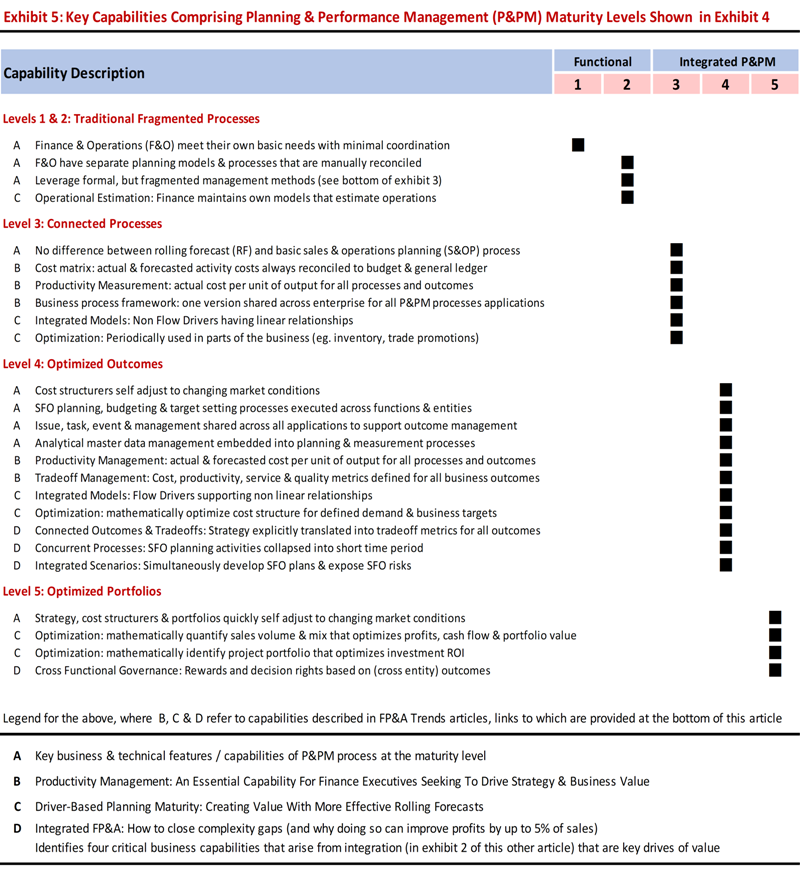
Details of the capabilities [shown above in exhibit 5] are contained in three separate FP&A Trends articles, links to which are provided at the bottom of this article. Each capability in the exhibit has a letter reference, which is described in the legend at the bottom of the exhibit. Three key insights can be gleaned from this exhibit:
- Specific capabilities [in stages 3 to 5] comprise the gaps of GMC’s processes
- Four of these capabilities [labelled “D”] are the primary gaps because they comprise the others
- The probability is high that these four capabilities are missing from IBP and IFP applications
This last point is of particular note. These four capabilities play a central role in helping global organizations manage complexity. Their absence undermines the ability to manage complexity costs. This is important because [as noted in the “ Integrated FP&A ” article] complexity costs can approach 5% of sales. In this context, these capabilities need to be a key focus of strategically focused finance executives.
Key Takeaways
Bob, like other forward-thinking finance executives, understood the importance of integrating SFO P&PM processes. Especially as a means of coping with complexity. Despite this understanding, GMC still failed to establish mature forms of integrated processes that could support their objectives. Here are four things you can learn from GMC’s experience that will help you to avoid these mistakes:
- Develop a healthy skepticism of IBP, IFP and other solutions, like those in exhibit 1. Many lack the capabilities to support mature forms of integrated processes.
- Employ a holistic approach for developing SFO P&PM processes. As GMC learned, failure to define integrated SFO processes and requirements at the outset, can lead to missed requirements and the capability gaps that they are now coping with.
- Consider the views of technology analysts, but remember that they view technologies from functional perspectives. Not from a process-driven one that brings together SFO perspectives. Without understanding this, their views can lead organizations in the wrong direction.
- Develop a shared understanding of what fully integrated P&PM processes look like, the specific capabilities that comprise them and why they are important for driving strategy and value.
This last point is especially important. Had GMC established such an understanding at the outset of their program, they could have avoided the situation in which they found themselves. In this context, the insights in this article can help to get you started in the right direction.
Related articles

The cost of complexity can be significant – upwards of 5% of sales in global organizations. Forward-thinking...

Mature driver-based planning models are an essential component of effective rolling forecast processes in complex, global...

Managing enterprise productivity is an essential capability for value-focused Finance executives. It provides the basis for...
Subscribe to FP&A Trends Digest

We will regularly update you on the latest trends and developments in FP&A. Take the opportunity to have articles written by finance thought leaders delivered directly to your inbox; watch compelling webinars; connect with like-minded professionals; and become a part of our global community.
Create new account

- Group Training
- Individual Training

- Individual Certification
- Corporate Certification
- Companies Certified
- Testimonial
- Companies w/ Certification
- Levels of Certification
- Certification Details
- Sample Exams
- Recertification
- Preparation Materials
- Exam Schedule
- CPF Prep/Review

- Research Reports
- Virtual Conference Recordings

- Cancellation Policy
- Refund Policy for Events
- Ambassador Program
- Member Companies
- Partnership
- Apply to Speak
- Subscription
- S&OP Self-Assessment
- Sponsored Content
- Become a Sponsor
- Exhibit at IBF Events

What Is Integrated Business Planning (IBP)?
The term today is highly debated between two groups of practitioners: one defines it as the planning process that includes demand review, supply review, product management review, management business review, financial reconciliation, and business strategy. Some view IBP as a broader version of S&OP, which also emphasizes the role of strategic planning. It continues to evolve.
Integrated Business Planning
Today’s market requires businesses to plan more rapidly and assess multiple scenarios at once. We help connect leading technologies and bespoke methodologies through integrated business planning to break down silos and unlock new routes to savings and growth.

Mike Ballestrin
EY Canada Finance Consulting Leader

KB Brinkley
EY Canada Integrated Business Planning Leader
What EY can do for you
Business, markets, expectations and technology have all changed. These monumental shifts necessitate a new framework for business planning, one that’s more integrated than ever before.
Integrated business planning is about connecting what finance and the business are doing, so the organization can react more quickly to any number of external changes, shocks or disruptions. That collaborative approach accelerates speed to impact.
We’ve created a distinctive, integrated approach to business planning that can set your organization apart. Our approach is scalable to meet the specific needs of any given business, at any stage on the growth journey. We work with organizations to build a customized integrated business planning framework that:
- Dismantles operational silos and aligns processes so functional groups can make better decisions around strategic direction and tactical execution
- Employs machine learning, AI and proprietary EY accelerators to deliver up-to-date insight
- Empowers clients to better understand the state of play
- Surfaces insight to help decision-makers buy, invest, manage and save
- Creates a sustainable, transparent and controlled method of planning ahead
- Cultivates shared planning ownership between finance and operations
- Leverages world-class strategic alliances to help organizations abandon outdated, manual ways of working and embrace new possibilities
Our IBP services include:
- Full-service process and technology implementation
- Upfront collaboration session to define and align key business objectives with stakeholders across functions
- EY wavespace session to co-create an action plan and build out the future vision for your organization on IBP
- Rapid assessment to baseline performance, applying advanced EY tools and building transformation business cases
- Prioritization and implementation of use cases to realize benefits of IBP
Applying integrated business planning is key to navigating market complexity and long-term financial health. The best-performing companies merge operational and financial planning to foster agility and drive valuable bottom-line results. By bringing together better tech, better thinking and better cross-functional teaming, we can tailor our approach to your specific industry or business journey. This is how we empower clients to overcome today’s challenges, drive material improvements to financial performance, scale up and set ambitious new organizational and growth goals.
EY alliance and ecosystem relationships for integrated business planning
Our roster of key alliances and partnerships enables accelerated transformations tailored to the most specific industry and business journeys.

Our latest thinking
Like what you’ve seen? Get in touch to learn more.
Connect with us
Our locations
Legal and privacy
Accessibility
EY refers to the global organization, and may refer to one or more, of the member firms of Ernst & Young Global Limited, each of which is a separate legal entity. Ernst & Young Global Limited, a UK company limited by guarantee, does not provide services to clients.
EY | Assurance | Consulting | Strategy and Transactions | Tax
EY is a global leader in assurance, consulting, strategy and transactions, and tax services. The insights and quality services we deliver help build trust and confidence in the capital markets and in economies the world over. We develop outstanding leaders who team to deliver on our promises to all of our stakeholders. In so doing, we play a critical role in building a better working world for our people, for our clients and for our communities.
EY refers to the global organization, and may refer to one or more, of the member firms of Ernst & Young Global Limited, each of which is a separate legal entity. Ernst & Young Global Limited, a UK company limited by guarantee, does not provide services to clients. For more information about our organization, please visit ey.com.
© EYGM Limited. All Rights Reserved.
EYG/OC/FEA no.
This material has been prepared for general informational purposes only and is not intended to be relied upon as accounting, tax, or other professional advice. Please refer to your advisors for specific advice.

Welcome to EY.com
In addition to cookies that are strictly necessary to operate this website, we use the following types of cookies to improve your experience and our services: Functional cookies to enhance your experience (e.g. remember settings), and Performance cookies to measure the website's performance and improve your experience . , and Marketing/Targeting cookies , which are set by third parties, allow us to execute marketing campaigns, manage our relationship with you, build a profile of your interests and provide you with content or service offerings in accordance with your preferences.
We have detected that Do Not Track/Global Privacy Control is enabled in your browser; as a result, Marketing/Targeting cookies , which are set by third parties that allow us to execute marketing campaigns, manage our relationship with you, build a profile of your interests and provide you with content or service offerings in accordance with your preferences are automatically disabled.
You may withdraw your consent to cookies at any time once you have entered the website through a link in the privacy policy, which you can find at the bottom of each page on the website.
Review our cookie policy for more information.
Customize cookies
I decline optional cookies
What is Monarch Energy and how does it plan to invest $1B in Rockford?

California-based Monarch Energy is looking to invest $1 billion in Rockford and spark growth at the Chicago Rockford International Airport.
Although the final details are being worked out, officials say the project could come with hundreds of jobs and an even bigger boon for the local economy in years to come. Here's what we know.
What is Monarch Energy?
Monarch Energy was founded in 2021 in San Diego with a mission to transform today's hydrogen supply chain by utilizing clean molecules derived from water and zero-carbon electricity. The company is currently developing a pipeline of projects containing more than 4 GW of future installed electrolyzer capacity across the United States.
What would the company manufacture in Rockford?
Monarch's Rockford facility would use emissions from nearby landfills and convert them into American-made sustainable aviation fuel (SAF) that could be used at Rockford International Airport and beyond.
What is sustainable aviation fuel?
Sustainable aviation fuel is an alternative fuel made from non-petroleum feedstocks like municipal solid waste, agricultural waste and wood. Compared to conventional jet fuel, 100% sustainable aviation fuel can reduce greenhouse gases by more than 90%, depending on its feedstock. According to the United States Department of Energy, more than 360,000 commercial flights have used SAF at 46 different airports largely in the United States and Europe.
Where is Monarch planning to build?
The company has not announced a site yet. But, there is speculation that Monarch could become part of a rail-serviced industrial park planned near the Chicago Rockford International and the Winnebago-Ogle County line. Officials say the park could see its first users by 2027.
How many jobs will the Monarch project create?
Officials say the Monarch facility in Rockford will create between 400 and 500 construction jobs and around 50 permanent positions when the plant opens.
Who will the company do business with?
The sustainable aviation fuel Monarch produces in Rockford would be immediately utilized by companies like Amazon and UPS, and others that have hubs at the airport. The fuel could also be sold around the world as more corporations are vowing to be carbon-neutral in coming years. That means global companies like Samsung, Panasonic and others would turn to Rockford to fulfill those promises.
Jim Hagerty writes about business, growth and development and other news topics for the Rockford Register Star.
- Certification
- News & Resources
- About WBENC
- Meet the Team
- Board of Directors
- Women’s Enterprise Forum
- Leadership Council
- Annual Reports
- Regional Partner Organizations
- Media Partners
- All Partners
- Top Corporations for Women’s Business Enterprises
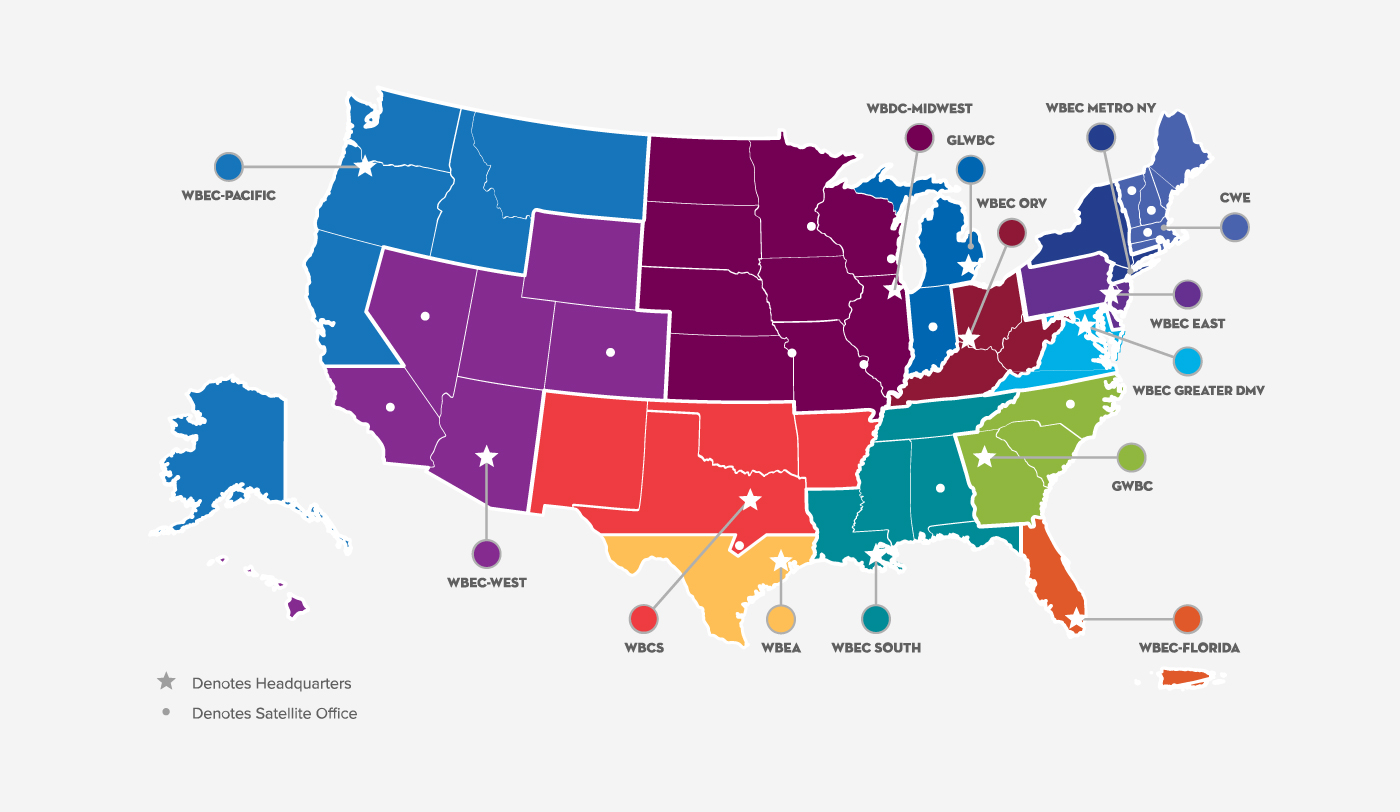
- Get Certified
- Certification Eligibility
- Benefits of Certification
- Certification Process
- Documentation Required
- How to Apply
- WOSB Certification
- Eligibility
- Currently Certified
- Resources for WBEs
- Recertification
- Recertification Documentation
- WBENCLink2.0
- Certification Support
- Frequently Asked Questions
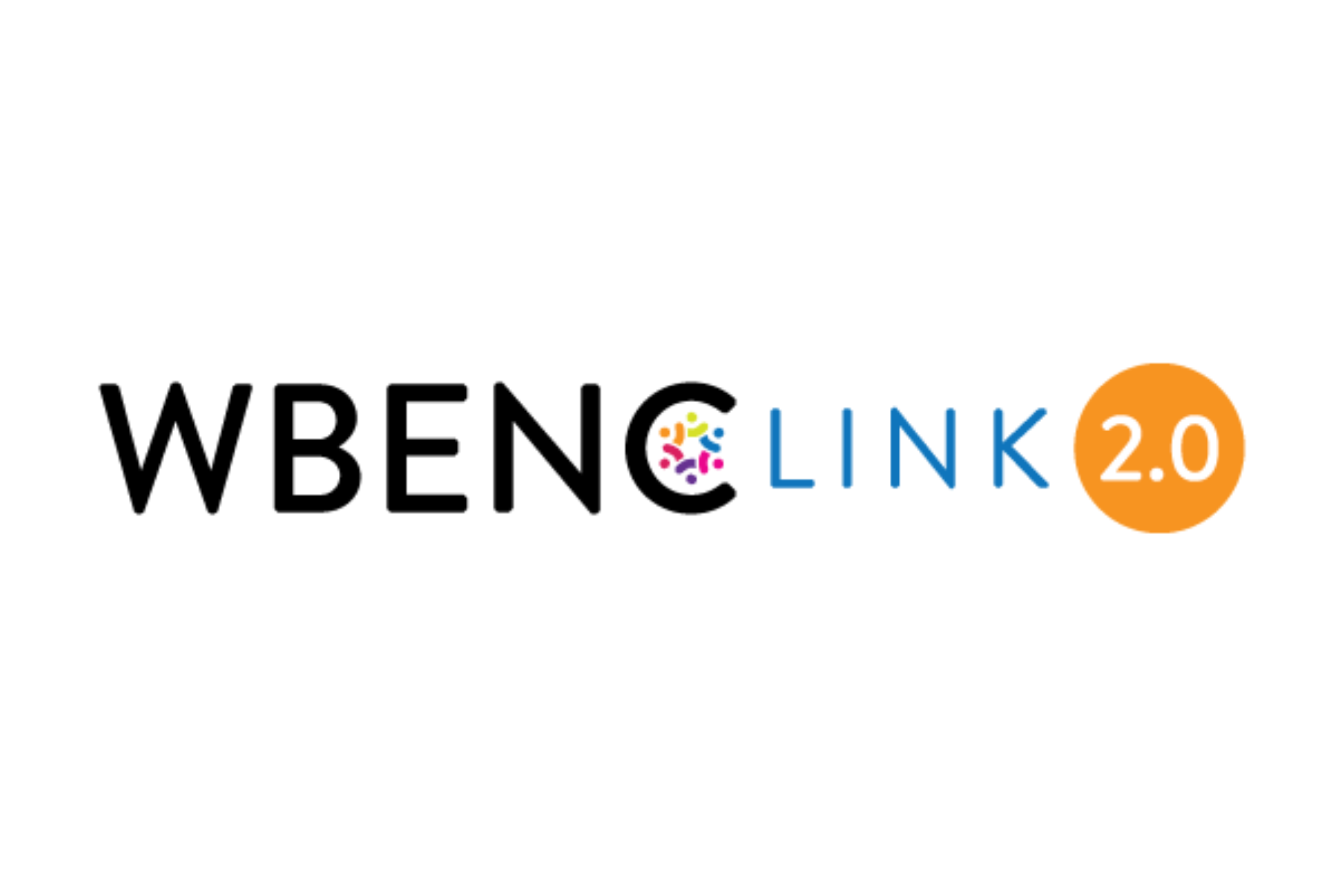
- Executive Education
- LIFT Financial Excellence
- Networking & Engagement
- Pitch Opportunities
- Scholarships & Grants
- Speaking Opportunities

- 2024 National Conference
- Sponsorship
- Corporate Membership
- Member Benefits
- Member Dues
- Current Member List
- Buy Women Owned
- ACTIntentionally
- Get Involved
- WBENC Ambassadors

- News & Resources
- Contribute Content
- Marketing & Media Kits

Get to Know the 2024 WBE Stars: Gwen Hale, Reagan Mechanical LLC
In 2024, wbenc continues its inspiring tradition by celebrating the wbe stars for their remarkable achievements, contributing invaluable leadership, innovation, and influence on the dynamic business landscape. each handpicked by one of the 14 regional partner organizations (rpos), these women serve as a wellspring of inspiration for others within their communities. the recognition they receive through the wbe star award is a powerful testament to the profound impact they’ve made in their respective business environments..
The 2024 WBE Stars received their accolades at the vibrant WBENC National Conference, a grand event held from March 19-22, 2024, in Denver, Colorado. This conference was a hub of innovation and networking, drawing nearly 5,000 entrepreneurs and business leaders who celebrated the accomplishments of these extraordinary women.
But the celebration doesn’t end there. Throughout 2024, WBENC will continue to spotlight these trailblazing women in various dynamic formats, including an engaging article series and captivating feature articles in WE USA Magazine this summer. Prepare to be inspired!
Meet Gwen Hale, President and CEO of Reagan Mechanical, with the Great Lakes Women’s Business Council (GLWBC) Regional Partner Organization. Prior to assuming the helm at Reagan Mechanical, Gwen served as Vice-President of Hale Contracting responsible for operations and management of construction. With more than twenty-five years in the construction industry, Gwen’s versatile background has allowed her to work successfully in all facets of field and office operations, including estimating, field supervision, project management, and business development.
Gwen’s leadership has contributed to the successful completion of numerous diverse commercial, industrial and automotive projects, together with joint venture and program management projects, which include professional sports arenas, airports, education facilities, healthcare and industrial facilities.
Get inspired by Gwen and stay tuned for our 2024 WBENC Stars article series throughout 2024!

Reagan Mechanical LLC is an HVAC Service and Mechanical company. They focus on piping fabrication, plumbing and sheetmetal. Appointed to the Board of Professional Engineers by Former Governor John Engler, Gwen served from 2002 – 2008. The Board is responsible for establishing requirements for the registration of persons practicing engineering, as well as orders, rules, and regulations that specify standards of professional conduct. The Board also provides penalties when standards are not met.
A key challenge she sees in her industry is the loss of craftsmanship. Skilled technicians are retiring and there is a limitation of talent and experience in key areas such as pipefitters and plumbers. It is essential for her to prioritize the development of these sectors within her industry and be intentional to increase recruitment, mentorship, and education.
The 2024 theme is AMPLIFY. What does AMPLIFY mean to you?
“The AMPLIFY theme serves as a rallying cry and call to action for women entrepreneurs to create, connect and collaborate. AMPLFY articulates the rising of women in all industry sectors to raise their voices and increase the awareness and opportunity for women entrepreneurs to step into the professional purpose and raise to their next level to industry impact.”
When and how was your business started?
Reagan Mechanical was established in 2015 as a women-owned, minority-owned Michigan based business. Reagan Mechanical evolved out of Hale Contracting, Inc., established in 1997. In my role as co-owner of Hale Contracting, I saw a need to further my impact in this industry by launching Reagan Mechanical.
What is one way you recommend people to “AMPLIFY” the impact of the WBENC network in the next 2 years?
One way people can AMPLIFY their impact of the WBENC network in the next 2 years is through connection. When we utilize the opportunities and resources the WBENC offers we expand our connections and build relationships that matter for our businesses and for the customers we serve. We are able to drive the business further and potentially expand the services available to our customers, directly and indirectly. We also establish greater learning opportunities from these relationships and connections that we make from other in business who have experiences that come with best practices and lessons learned.
How are you planning to AMPLIFY the mission of the WBENC network during your time as a WBE Star?
Mentorship and sponsorship matter in business, it always has. I plan to show up as a resource and a mentor for women entrepreneurs particularly. I believe that the experiences I have had as a business owner for that last 25 years, and as a Black woman in an industry dominated by white males has allowed me to have a unique understanding and perspective that can make a difference and can be an asset to entrepreneurs regardless of how long they have been in business. As I continue to learn from the mentors in my life. I hope to impart that knowledge and share the resources that I have acquired.
Provide an example of how innovation helped you overcome a challenge, pivot, or adapt your business.
Technology and Artificial Intelligence (AI) has influenced design that have been beneficial in my business. The global pandemic required the world to pivot in every way and it required us to depend on technology differently from how we have meetings to how we design the work that we do. Technology allowed Regan Mechanical to pivot, stay relevant and to sharpen our ability to do business.
What areas of innovation do you foresee for women entrepreneurs over the next few years?
Within the construction industry, there are three areas of innovation that I foresee for women entrepreneurs: Project Management, Engineers, and Design. These areas currently dominated by men are core areas in the construction industry where women could make a powerful impact and innovate in ways what makes the business of doing business better.
What have you learned about yourself as a leader from mentoring or coaching others?
I have learned there is more to learn, thus as a mentor and coach. I am keenly aware that I am learning as much if not more than I am sharing. Business, if successful, is not stagnant, but always evolving, so I find myself learning and growing from both my mentors and mentees.
What do you view as benefits of being part of the WBENC network?
The benefits of being a part of WBNEC network are numerous and include helping other women-based businesses and mentoring upcoming WBE’s connecting and networking to open doors for opportunities for contracts and obtaining those contracts.
How has engaging in the WBENC Network as a Certified WBE helped your company?

Engaging the WBENC Network as a Certified WBE has helped in all of the ways previously mentioned. Mentorship, resources, support, training, and networking, just to name a few.
What suggestions would you like to share with a newly certified WBE who is looking to get involved in the WBENC community?
The resources I recommend that have been helpful on my journey are seminars, conferences, and as much professional training as possible. WBENC is a perfect resource for these.
- Learn About WBENC
- Certify Your Business
- Become a Corporate Member
- Support Women-Owned Businesses
- WBENCLink2.0 Login
Subscribe to our email newsletters and alerts for the latest news, opportunities, and resources.
- Privacy Policy
- Terms of Use
What to know about Gov. Newsom’s plan to offset California’s $45-billion deficit

- Show more sharing options
- Copy Link URL Copied!
Faced with a $44.9-billion budget deficit, Gov. Gavin Newsom described a plan to shrink the size of state government and slow his progressive policy agenda by eliminating 10,000 vacant state jobs, pausing an expansion of subsidized childcare and cutting billions in funding for climate change programs.
Newsom’s revised $288-billion budget proposal, announced Friday, projected California’s deficit to be $7 billion more than the shortfall his administration expected in January. The grim forecast was driven by lower than projected state revenues, continuing a pendulum swing from the fiscal boom of the COVID-19 pandemic.
“These are things we worked closely with the Legislature to advance,” Newsom said of the cuts. “None of this is the kind of work you enjoy doing, but you’ve got to do it. We have to be responsible. We have to be accountable.”
Newsom’s plan to close the deficit relies on $17.3 billion in savings from budget cuts he and lawmakers agreed to in April and using $4.2 billion from the state’s rainy day fund and budget reserves for the upcoming fiscal year.
The proposed spending reductions Newsom touched on Friday also reverse and slash an additional $8.2 billion in funding in 2024-25.
Newsom’s proposal includes $3.6 billion less for programs related to fighting climate change, said H.D. Palmer, a spokesperson for the Finance Department. The plan would also cut $2 billion over two years from a program to expand internet connectivity to underserved homes, businesses and community institutions.
The governor’s revised budget proposal, which includes updated revenue projections after the state income tax filing deadline, typically jump-starts negotiations with Democratic leaders in the Senate and Assembly over a final fiscal plan for the upcoming year. The state Constitution requires lawmakers to approve the state budget by June 15.
An ‘incomplete’ plan
The governor’s budget plan released Friday was incomplete compared to prior years. The administration provided only a 50-page summary of his proposal, compared to the more detailed, 260-page document Newsom released in January.
Newsom’s budget news conference was originally scheduled for next Tuesday, the deadline for the governor to share his revised budget with the state Legislature. But Newsom is flying to Rome that day to speak at a climate conference at the Vatican and bumped his presentation up to Friday.
The change left the state Department of Finance, the fiscal arm of his administration, short on time to finalize a full budget summary, and additional documents, Palmer said. More information, his aides said, will be made available when additional documents are made public on Tuesday.

Public defenders, foster kids, climate: Programs created during California’s boom may stall amid deficit
Facing tough financial choices to close a budget shortfall, Gov. Gavin Newsom is proposing cuts to programs that benefit foster kids, public defenders and more
April 18, 2024
How bad is the budget problem?
Newsom cast California’s current financial situation as a return to normal after the federal government provided trillions of dollars in funding to individuals, families, businesses and state governments during the COVID-19 pandemic, payouts that resulted in a historic surplus in California.
But those flush times did not last, and poor revenue forecasts in recent years have also deepened the state’s fiscal troubles.
Newsom’s estimate of a $100-billion surplus two years ago ended up far too rosy, and revenue in subsequent years also fell short of projections. A decision by the federal government to delay the 2022 federal income tax deadline from April to November due to winter storms complicated California’s ability to project revenues last year.
Newsom’s plan seeks to solve the budget deficit for the next two budget years, including additional cuts, reductions and delays to solve an estimated $28.4-billion deficit in 2025-26.
State Sen. Roger Niello (R-Fair Oaks) called out the difference between Newsom’s deficit estimates and much higher models from the Legislative Analyst’s Office.
“He continues to hang on to the unrealistically low deficit with the clear expertise of the LAO stating that the problem is significantly greater than that and that just means that his budget solutions are shooting too low,” Niello said. “We’ll get to the end of another fiscal year where we’re in trouble again, just like this one.”
Why does the deficit number keep changing?
In January, the Newsom administration predicted that California would have a $37.9-billion deficit to reckon with in the budget that lawmakers adopt in June.
Newsom and leaders of the Senate and Assembly reached an early agreement in April on $17.3 billion in reductions though most of those changes will not be passed into law until next month. Lawmakers passed a budget trailer bill that lowers unspent funding allocations in 2022-23 and 2023-24 by $1.6 billion last month.
The deficit number Newsom presented Friday subtracts the $17.3 billion in cuts agreed to earlier from the $37.9-billion deficit estimate from January.
Revenues have fallen short of expectations since January, deepening the budget problem by $7 billion.
Newsom is referring to the shortfall as $27.6 billion in 2024-25, but California is making cuts and reductions to solve a total budget deficit of $44.9 billion this year.

Newsom called it a ‘gimmick.’ Now he’s using the trick to lower California’s massive deficit
With a massive budget deficit in California, Gov. Gavin Newsom is adopting a ‘gimmick’ he previously reversed in an effort to push the problem forward into future years.
April 11, 2024
How will the governor’s cuts affect education?
Under Proposition 98, California has a minimum funding guarantee for schools and community colleges. Newsom is proposing an unusual maneuver to go back and lower the funding requirement for 2022-23 to reflect the lower-than-expected state revenues that came in late last year. The change could ultimately reduce funding for schools by tens of billions of dollars in future years and launch a monumental fight over education funding at the state Capitol.
Early childhood programs face cuts of more than $2 billion in the governor’s new budget proposal, including a 45% cut for the CalWORKS home visiting program , which provides supportive visits to about 3,000 low-income families following the birth of a baby.
He wants to reduce the Middle Class Scholarship program by $510 million and cut $550 million from a program that helps build and upgrade facilities for children in preschool and transitional kindergarten over the next two budget years.
Newsom called a decision to pause $1.4 billion planned to expand child-care availability over two years “difficult,” but a necessary trade-off in order to pay child-care workers higher wages.
“The state was finally making progress on childcare and early childhood initiatives which have been so ignored for so many years. To now cut back on that is disastrous for families and for our future,” said Ted Lempert, president of Children Now and a former California Assembly member.
What about healthcare?
Among proposed healthcare cuts is the elimination of more than $300 million in state and local public health funding — a move that “astounded” organizations like the County Health Executives Assn. of California, which pointed to COVID-19 pandemic woes that were worsened by underfunding and questioned if the state was backtracking.
Newsom also proposes eliminating hundreds of millions from programs meant to train and recruit health workers including nurses and social workers — both industries that have faced staffing shortages.
Healthcare providers who serve California’s low-income patients insured by Medi-Cal stand to lose extra pay meant to encourage healthcare facilities’ participation in the safety net program. The governor’s proposal takes more than $6 billion over multiple years meant for provider rate increases from a tax on managed healthcare organizations, known as the MCO tax, and uses it to support the Medi-Cal program in other ways.
Jodi Hicks, president and CEO of the Planned Parenthood Affiliates of California, said she was “deeply disappointed” by Friday’s budget plan, saying it will “jeopardize access to not just sexual and reproductive care but quality, affordable health care across the board for the nearly 15 million Californians who rely on Medi-Cal.”
Will prisons lose funding?
Newsom’s proposal includes savings from the newly announced deactivation of 46 housing units at 13 state prisons, which would save $80.6 million. This comes as California’s prison population has declined by nearly 25% since 2019 and as the state prepares for the closure of its third prison, which Newsom said is now planned to close as early as November, five months ahead of schedule.
The governor said that, while he is interested in further reducing “the larger footprint” of the prison system, “we want to be mindful of labor concerns, community concerns and trends.” He also expressed concern about the possibility of unanticipated increases in prison populations . A measure that could appear on the November ballot calls for rolling back some criminal justice reforms that have helped reduce incarceration.

Newsom has approved three California prison closures but resists pressure to shutter more
Gavin Newsom could save the state $1 billion annually by closing five more prisons, analysts say. The governor finds himself in a precarious political spot.
April 1, 2024
Will the plan hurt workers?
The April agreement between lawmakers and the governor included $762 million in savings by pausing hiring for vacant state jobs. Newsom’s updated proposal permanently deletes 10,000 open positions, which unions viewed as a potentially better option than furloughs or delaying planned salary increases to save money.
Details of a costly plan to hike pay for healthcare workers to at least $25 per hour are still to come, following months of negotiations between Newsom, unions and hospital leaders.
Newsom signed a bill last year that imposed a new industry minimum wage for California healthcare workers, but has voiced concerns about how fast the state can move on wages due to the deficit. His department estimated that the wage hikes could cost the state $2 billion in its first year of implementation — a figure that SEIU California, the union backing the measure, rushed to refute, urging hospitals to pay a bigger share of the costs.
Newsom was tight lipped on the details on Friday but said a deal is near.
“This budget will not be signed without that deal,” Newsom said Friday.
The budget proposal shared Friday does not include funding for a healthcare minimum wage increase, Palmer said.

As deficit estimate hits $68 billion, Newsom seeks ‘major changes’ to healthcare wage law
Gov. Gavin Newsom said his staff has been working with Democrats in the Legislature on the state’s healthcare minimum wage law in light of budget concerns.
Dec. 7, 2023
What else could be coming?
Negotiations are under way in the Legislature to place as many as three bonds on the November ballot that would ask voters to approve borrowing money to pay for low-income housing, school construction projects and climate-related infrastructure for adapting to floods, fires and droughts. Newsom declined to answer a question about how many of those he would like to go on the ballot.
Newsom said the close-call he experienced in March when his Proposition 1 bond for mental health facilities passed by barely more than 50% has “sobered” conversations about how much voters are willing to support borrowing measures.
“The public wants to see results. They’re not interested in inputs, they’re not interested to talk about how much money we’re spending,” he said. “They deserve results and they demand results. And so when we’re out there promoting these bonds, we need to be mindful of that.”
Times Sacramento bureau chief Laurel Rosenhall and staff writer Jenny Gold contributed to this report.
More to Read

Column: Lots of complaining about California’s tax system. Time to fix it
May 13, 2024

Newsom touts billions in climate spending through California’s cap-and-trade program
May 9, 2024

Newsom and Democratic lawmakers detail first California budget cuts totaling $17 billion
April 4, 2024
Get the L.A. Times Politics newsletter
Deeply reported insights into legislation, politics and policy from Sacramento, Washington and beyond. In your inbox three times per week.
You may occasionally receive promotional content from the Los Angeles Times.

Taryn Luna covers Gov. Gavin Newsom and California politics in Sacramento for the Los Angeles Times.

Mackenzie Mays covers state government and politics in the Los Angeles Times’ Sacramento bureau. Previously, she worked as an investigative reporter for Politico, the Fresno Bee and the Charleston Gazette-Mail. In 2019, she received the National Press Club Press Freedom Award for her political watchdog reporting. She is a graduate of West Virginia University and proud Appalachian.

Anabel Sosa is a reporter for the Los Angeles Times’ Sacramento bureau, covering legislation and politics. She is a graduate of UC Berkeley’s School of Journalism and a California Local News fellow.
More From the Los Angeles Times

Single-payer healthcare meets its fate again in the face of California’s massive budget deficit

Secret FBI files allege that former L.A. city attorney lied to federal investigators and likely obstructed justice

California psychedelics bill that would bring ‘magic mushrooms’ into the mainstream fails – again

Gavin Newsom, during his speech at the Vatican on climate change, accuses Trump of ‘open corruption’
May 16, 2024
- Share full article
Advertisement
Supported by
Comcast Plans Streaming Bundle With Netflix and Apple TV+
The bundle, called StreamSaver, is the latest joint effort from entertainment companies looking to woo price-weary customers.

By Benjamin Mullin
Comcast, the parent company of NBCUniversal, is planning to offer its streaming service Peacock in a bundle with Netflix and Apple TV+, Brian Roberts, the company’s chief executive, said at an investor conference on Tuesday.
Called StreamSaver, the bundle will be sold at a deep discount compared with subscribing to all three services separately, Mr. Roberts said. He didn’t specify a price for the service, which is expected to debut this month.
“We’ve been bundling video successfully and creatively for 60 years,” Mr. Roberts said. “This is the latest iteration of that. And I think this will be a pretty compelling package.”
Over the past year, several entertainment companies have joined forces to entice customers who are weary of signing up and paying for numerous individual streaming services.
Warner Bros. Discovery, Fox and Disney announced this year that they were teaming up to offer a streaming service with games from the National Basketball Association and the National Football League. Last week, Disney and Warner Bros. Discovery said they would bundle their streaming services, selling users a package that included Disney+, Hulu and Max.
Comcast has long offered its users a menu of streaming services on Xfinity, its package of services that includes cable television and broadband internet. For years, the company has offered services like Netflix and Apple TV+ as add-ons to its existing television bundle, acting as a vendor for those companies. This is the first time that Comcast will offer both services as part of a discounted bundle.
Comcast, which has millions of broadband and cable television customers across the United States, has different incentives to bundle streaming services than many of its competitors have. If Comcast can give its customers additional reasons to stick with the company, or persuade them to pay for more features through Xfinity, the effort to bundle services will have been worth it.
Many other internet providers have sold bundles that include streaming services. When Disney+ launched, Verizon offered a promotional bundle with that service. When the short-lived, short-form streaming service Quibi launched, T-Mobile offered to bundle its wireless offering with that service.
Comcast has been willing to spend big to gain a foothold in the competitive video streaming business. Peacock, which launched in 2020, lost $2.7 billion last year, Comcast said in a filing, but paying subscribers increased to 31 million. The company has said Peacock’s losses were narrowing as the service matured.
Benjamin Mullin reports on the major companies behind news and entertainment. Contact Ben securely on Signal at +1 530-961-3223 or email at [email protected] . More about Benjamin Mullin

IMAGES
VIDEO
COMMENTS
March 16, 2021. Think of modern integrated business planning, or IBP, as a mashup of supply chain optimization, financial planning and analysis (FP&A) and operational best practices, powered by a companywide culture that's all about delivering the speed, savings and responsiveness today's consumers demand while managing risk.
Integrated business planning framework. Integrated Business Planning (IBP) is a holistic approach that integrates strategic planning, operational planning, and financial planning within an organization. IBP brings together various functions, including sales, marketing, finance, supply chain, human resources, IT and beyond to collaborate across ...
A typical IBP process involves several stages: Data Collection and Analysis: Gathering relevant data (e.g., sales forecasts, production capacities, inventory levels and financial projections) from different departments. Demand Planning: Predicting future demand based on historical data, market trends, customer feedback and sales forecasts ...
One global manufacturer set up its integrated business planning (IBP) system as the sole way it ran its entire business, creating a standardized, integrated process for strategic, tactical, and operational planning. Although the company had previously had a sales and operations planning (S&OP) process, it had been owned and led solely by the supply chain function.
Integrated business planning (IBP) is a process for translating desired business outcomes into financial and operational resource requirements, with the overarching objective of maximizing profit and / or cash flow, while cutting down risk. The business outcomes, on which IBP processes focus, can be expressed in terms of the achievement of the ...
Elements Of Integrated Business Planning. The three main parts of integrated business planning are categorized as "Plan," which involves creating a strategy, "Execute," which involves carrying out the plan; and "Monitor and Adjust," which involves reviewing and making changes as needed. The Plan element involves the initial step of ...
IBP Process: How Does it Work. The Integrated Business Planning process is a framework to address the C-suite needs and help them implement the business strategy and manage uncertainty to improve decision-making. The secret sauce of IBP is a collaboration between the different teams under a single view of the numbers that must unequivocally be ...
What is Integrated Business Planning (IBP) Integrated business planning — the subject of a new report from the Association for Finance Professionals (AFP) — is a single holistic plan that seamlessly connects strategic plans with sales plans, operational plans, and financial plans while balancing practical constraints about the availability ...
Integrated Business Planning (IBP) is the business planning process that extends the principles of Sales and Operations Planning (S&OP) throughout the value chain. It is to create a bridge between strategy and execution. IBP is a next step for companies that already have an S&OP process in place. It is a next step because it integrates the ...
Strategic business planning: Aligning all business plans with the company's long-term strategic goals, including financial objectives. Integrated reconciliation: Harmonizing plans across the business to ensure alignment and commitment from all departments. Key benefits of Integrated Business Planning. IBP offers a multitude of advantages ...
Integrated business planning (IBP) is important because functional and technical silos across organizations result in flawed decision-making. Within every enterprise there are many thousands of decisions being made and business processes to be aligned, resulting in a final business strategy. Among those decisions are: commercial decisions ...
Intelligent Modeling as a Requirement for Successful IBP. Successful Integrated Business Planning includes unique technology capabilities. Below are the most important ones: An underlying holistic model that represents the business as it behaves in reality, including business, financial, and supply chain constraints.
Integrated business planning is a methodology that organizations can use to help them align their goals with their operation and strategies. IBP takes into account factors like a company's supply chain management, marketing and sales techniques, financial situation, and resources. Management consultant Oliver Wight first developed IBP in the 1980s.
Integrated business planning (IBP) directly addresses this problem, connecting systems, data and planning across business functions with a unified experience, common evidence and coordination that make better, faster decisions possible. This integration of business plans gives organizations the essential
1. You can deliver on your overall company mission. IBP builds the framework for true integration and a unified approach. It can cover all your organization's financial planning needs. This can include planning cash flow, managing operational budgets, or forecasting your sales, costs, and revenue.
An integrated business planning (IBP) process refers to scaling and connecting the planning activities across each business function, silo, and department. Hailed as the enabler of an innovation-ready environment, IBP also syncs business targets, budgets, operations, and business units across the entire organization.
Integrated planning is a cross-functional process that ensures all stakeholders are involved at the right time to align priorities across an organization. Integrated planning gives a complete view of resources and commitments. It makes sure that financial and capital resources are aligned in order to support strategic decision-making.
The next step is 'generation definition'. Depending on the organization's maturity, a roadmap is laid out with the appropriate number of generations. Each generation has a ... 3. Supply & Demand Chain Executive, Integrated Business Planning: Making Planning a Strategic Differentiator, September 30, 2016, accessed August 25,
Integrated Financial Planning (IFP) and Integrated Business Planning (IBP) mean different things to different people. Primarily because there is no universal definition of what "fully integrated" processes entail. This article presents a maturity model to explain what it means and the capabilities that comprise it.
What Is Integrated Business Planning (IBP)? The term today is highly debated between two groups of practitioners: one defines it as the planning process that includes demand review, supply review, product management review, management business review, financial reconciliation, and business strategy. Some view IBP as a broader version of S&OP ...
Integrated business planning is about connecting what finance and the business are doing, so the organization can react more quickly to any number of external changes, shocks or disruptions. That collaborative approach accelerates speed to impact. We've created a distinctive, integrated approach to business planning that can set your ...
Integrated business planning (IBP) is a holistic approach to planning that brings together all of the different planning processes within an organization. This includes demand planning, supply chain planning, financial planning, and commercial planning. The goal of IBP is to ensure that all of these planning processes are aligned and that they ...
Integrated business planning (IBP) is a strategy for connecting the planning functions of each department in an organization to align operations and strategy with the organization's financial performance.
0:45. California-based Monarch Energy is looking to invest $1 billion in Rockford and spark growth at the Chicago Rockford International Airport. Although the final details are being worked out ...
The 2024 WBE Stars received their accolades at the vibrant WBENC National Conference, a grand event held from March 19-22, 2024, in Denver, Colorado. This conference was a hub of innovation and networking, drawing nearly 5,000 entrepreneurs and business leaders who celebrated the accomplishments of these extraordinary women.
Takeda's net profit for the 2023 fiscal year was equivalent to about $927 million, down nearly 55% from the prior year. The company's revenue for 2023 was up almost 6% compared to the year ...
The annual CES expo is a wrap for this year, but before we all return to covering the rest of the biz and forget the big themes, here's a brain dump of a few cool technologies that broke cover or ...
May 10, 2024 Updated 5:19 PM PT. Faced with a $44.9-billion budget deficit, Gov. Gavin Newsom described a plan to shrink the size of state government and slow his progressive policy agenda by ...
Comcast, the parent company of NBCUniversal, is planning to offer its streaming service Peacock in a bundle with Netflix and Apple TV+, Brian Roberts, the company's chief executive, said at an ...